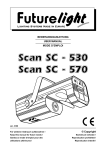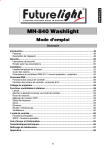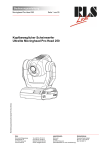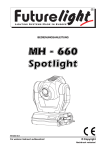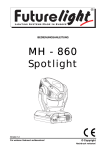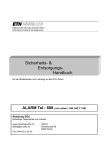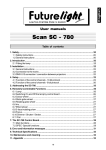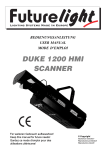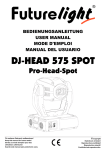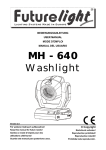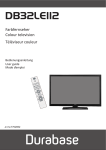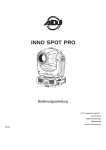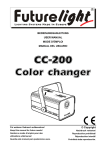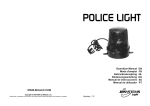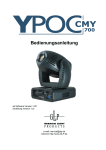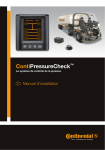Download Scan SC - 780 - Audiofanzine
Transcript
BEDIENUNGSANLEITUNG
USER MANUAL
MODE D’EMPLOI
Scan SC - 780
Für weiteren Gebrauch aufbewahren !
Keep this manual for future needs !
Gardez ce mode d’emploi pour des
utilisations ultérieures !
© Copyright
Nachdruck verboten !
Reproduction prohibited !
Réproduction interdit !
Weitere Produkte aus dem FUTURELIGHT-Sortiment:
Further products from the FUTURELIGHT-range:
www.futurelight.com
Autres produits de l’assortiment de FUTURELIGHT:
ARTIKELBESCHREIBUNG ......................................................... BEST.-NR.
ARTICLE DESIGNATION ............................................................ NO.
DESCRIPTION D’ARTICLE ........................................................ N° D’ART.
FUTURELIGHT LICHTEFFEKTE
FUTURELIGHT LIGHTING EFFECTS
FUTURELIGHT EFFETS LUMINEUX
FUTURELIGHT RT-150, DMX Zylinder,für EFR ............................. 51830500
FUTURELIGHT FX-150, DMX Flower, für EFR .............................. 51830550
FUTURELIGHT CIRCLE DMX f.800W Tunnellampe ..................... 51832030
FUTURELIGHT CROSS BEAM 400 36V/400W ........................... 51832050
FUTURELIGHT CROSS BEAM HMI 575 ..................................... 51832060
FUTURELIGHT SPIDER + Controller, HMI 575 ............................ 51832065
FUTURELIGHT DF-250 DMX Flower für ELC ............................... 51832085
FUTURELIGHT MIRACLE DMX-Contr., 575W HMI ....................... 51832090
FUTURELIGHT MIRACLE DMX-Contr., 1200 W HMI .................... 51832092
FUTURELIGHT CC-150 COLOR-CHANGER 150W EFR .............. 51832100
FUTURELIGHT CC-200 PRO COLOR-CHANGER 200 W ............ 51832200
FUTURELIGHT DUKE 1200 für HMI/OMI 1200 W ........................ 51832270
FUTURELIGHT SC-370 für MSD-200 W, DMX ............................. 51832286
FUTURELIGHT AS Advertising Scan schwarz ............................. 51832290
FUTURELIGHT AS Advertising Scan weiß .................................. 51832291
FUTURELIGHT PS/D-200 Promotion Scan schwarz .................... 51832292
FUTURELIGHT PS/D-200 Promotion Scan weiß ......................... 51832293
FUTURELIGHT PS/D-200 Sonderfarbe ........................................ 51832294
FUTURELIGHT SC-330 für 24 V/250 W G-6,35 ........................... 51832303
FUTURELIGHT SC-530 für 24 V/250 W G-6,35 ........................... 51832305
FUTURELIGHT SC-570 für MSD-200 W ...................................... 51832307
FUTURELIGHT SC-740 für HMI 575 W ........................................ 51832317
FUTURELIGHT SC-780 für HMI 575 W ........................................ 51832320
FUTURELIGHT SC-940 für HMI 1200 W ...................................... 51832323
FUTURELIGHT SC-980 für HMI 1200 W ...................................... 51832325
FUTURELIGHT SCAN H-150 für EFR-Lampe 150W .................... 51832330
FUTURELIGHT DP H250 für 24 V/250 W G-6,35 ......................... 51832340
FUTURELIGHT DP 200 für MSD 200 W Lampe ........................... 51832342
FUTURELIGHT DV 200 für MSD 200 W Lampe ........................... 51832344
FUTURELIGHT DOMINATOR MKII DMX HMI 1200 .................... 51832603
FUTURELIGHT MH-640 Washlight .............................................. 51833000
FUTURELIGHT MH-660 Spot ...................................................... 51833020
FUTURELIGHT CONTROLLER
FUTURELIGHT CONTROLLER
FUTURELIGHT CONTROLEURS
FUTURELIGHT DMX SCANCONTROL C-4 MKS ......................... 51832382
FUTURELIGHT HC-Contr.H-150/CC-/RT-/FX-150 ......................... 51834020
FUTURELIGHT C-16 CONTR.f.Mir.Cross.Spider .......................... 51834050
FUTURELIGHT UNIVERSAL DMX CONTROLLER ....................... 51834090
FUTURELIGHT CP16 Controller .................................................. 51834150
FUTURELIGHT CP-16 SC-3 Controller ........................................ 51834152
FUTURELIGHT CP16/H150 Controller ......................................... 51834160
FUTURELIGHT C32/H150 Controller ............................................ 51834166
FUTURELIGHT CP32 Controller .................................................. 51834168
FUTURELIGHT CP-64 SC-5 Controller ........................................ 51834190
FUTURELIGHT CP64 Controller .................................................. 51834200
FUTURELIGHT C-64 MKII Controller ............................................ 51834202
FUTURELIGHT C-128 Controller .................................................. 51834250
FUTURELIGHT CP-192 Controller ............................................... 51834260
2
Bedienungsanleitung
Scan SC - 780
Inhaltsverzeichnis
1. Sicherheit ....................................................................................................................... 4
1.1 Sicherheitshinweise ................................................................................................... 4
1.2 Bestimmungsgemäße Verwendung ............................................................................ 4
2. Einführung ..................................................................................................................... 6
2.1 Einsetzen der Lampe ................................................................................................. 6
3. Installation ...................................................................................................................... 7
3.1 Allgemeine Hinweise ................................................................................................. 7
3.2 Anschluß ans Netz ...................................................................................................... 7
3.3 Anschluß an den DMX-512 Controller / Verbindung Projektor - Projektor ................... 7
4. Bedienung ...................................................................................................................... 8
4.1 Funktionen der Steuerkanäle - 16 Bit ......................................................................... 8
4.2 Funktionen der Steuerkanäle - 8 Bit.......................................................................... 10
5. Adressierung des Projektors ...................................................................................... 11
6. Fernsteuerbare Funktionen ........................................................................................ 11
6.1 Lampe ..................................................................................................................... 11
6.2 Lampe über das Control Board schalten .................................................................. 11
6.3 Farbrad .................................................................................................................... 12
6.4 Statisches Goborad ................................................................................................. 12
6.5 Rotierendes Goborad .............................................................................................. 12
6.6 Effektrad .................................................................................................................. 12
6.7 Rotierendes 3-fach Prisma ...................................................................................... 12
6.8 Iris ............................................................................................................................ 12
6.9 Fokus....................................................................................................................... 12
6.10 Dimmer / Shutter / Strobe ....................................................................................... 12
6.11 Lüfter ...................................................................................................................... 12
7. Control Board .............................................................................................................. 12
7.1 Hauptfunktionen ....................................................................................................... 13
7.2 SPEC - Spezialfunktionen ........................................................................................ 13
8. Fehlermeldungen ........................................................................................................ 16
9. Technische Daten ........................................................................................................ 17
10. Wartung und Reinigung ............................................................................................ 18
11. Anhang ....................................................................................................................... 18
3
Achtung !
Gerät vor Feuchtigkeit und Nässe schützen !
Vor Öffnen des Gerätes Netzstecker ziehen !
LESEN SIE VOR DER ERSTEN INBETRIEBNAHME ZUR EIGENEN SICHERHEIT
DIESE BEDIENUNGSANLEITUNG SORGFÄLTIG DURCH!
1. Sicherheit
1.1 Sicherheitshinweise
Alle Personen, die mit der Aufstellung, Inbetriebnahme, Bedienung, Wartung und Instandhaltung dieses Gerätes
zu tun haben, müssen
- entsprechend qualifiziert sein
- diese Betriebsanleitung genau beachten
Seien Sie besonders vorsichtig beim Umgang
mit der Netzspannung 230 V. Bei dieser Spannung können
Sie einen lebensgefährlichen elektrischen Schlag erhalten!
Dieses Gerät hat das Werk in sicherheitstechnisch einwandfreiem Zustand verlassen. Um diesen Zustand zu
erhalten und einen gefahrlosen Betrieb sicherzustellen, muß der Anwender die Sicherheitshinweise und die
Warnvermerke, die in dieser Gebrauchsanweisung enthalten sind, unbedingt beachten.
Unbedingt lesen:
Bei Schäden, die durch Nichtbeachtung der Anleitung verursacht werden, erlischt der Garantieanspruch.
Für Folgeschäden, die daraus resultieren, übernimmt der Hersteller keine Haftung.
Bei der ersten Inbetriebnahme kann es Rauch - und Geruchserzeugung kommen. Hierbei handelt es sich nicht
um eine Störung des Gerätes.
Beachten Sie bitte, daß Schäden, die durch manuelle Veränderungen an diesem Gerät veruusacht werden,
nicht unter den Garantieanspruch fallen.
Der Aufbau entspricht der Schutzklasse I. Gemäß den Vorschriften muß daher der Schutzleiter (gelb/grüner
Draht) angeschlossen werden.
Der elektrische Anschluß sowie Wartungs - und Reparaturarbeiten dürfen nur von einer qualifizierten Fachkraft
durchgeführt werden.
Lichteffekte nicht über Dimmerpacks schalten.
Ersetzen Sie die Lampe und Sicherungen nur durch Produkte gleichen Typs und gleicher Qualität.
VORSICHT ! AUGENSCHÄDEN !
Blicken Sie niemals direkt in die Lichtquelle (gilt speziell für Epileptiker) !
1.2 Bestimmungsgemäße Verwendung
Das Gerät darf niemals ohne Lampe in Betrieb genommen werden!
Dieser Projektor wurde nur zum Gebrauch in geschlossenen Räumen konzipiert.
Vermeiden Sie Erschütterungen und jegliche Gewaltanwendung bei der Installation oder Inbetriebnahme des
Gerätes.
Eigenmächtige Umbauten und Veränderungen des Projektors sind aus Sicherheitsgründen verboten!
Sie können den Projektor überall gemäß den Bestimmungen installieren, achten Sie dabei jedoch auf eine
stabile Befestigung und auf eventuell frei herumliegende Kabel. Verwenden Sie aus Sicherheitsgründen immer
ein Fangseil.
Nehmen Sie das Gerät erst in Betrieb, nachdem Sie sich mit seinen Funktionen vertraut gemacht haben. Lassen
Sie das Gerät nicht von Personen bedienen, die sich nicht mit dem Gerät auskennen. Wenn Geräte nicht mehr
4
korrekt funktionieren, ist das meist das Ergebnis von unsachgemäßer Bedienung!
Das Gerät darf nicht in Betrieb genommen werden, nachdem es von einem kalten in einem warmen Raum
gebracht wurde. Das dabei entstehende Kondenswasser kann unter Umständen Ihr Gerät zerstören. Lassen
Sie das Gerät solange uneingeschaltet, bis es Zimmertemperatur erreicht hat!
Betreiben Sie das Gerät nur, nachdem Sie sich vergewissert haben, daß das Gehäuse fest verschlossen, und
alle nötigen Schrauben fest angezogen wurden.
1 - Gehäuseschrauben
2 - Feststellschraube
3 - Bügel
4 - Linse
5 - Ablenkspiegel
Rückseite:
6 - DMX Ausgang
7 - DMX Eingang
8 - Netzanschluß
9 - Sicherungshalter
10 - Control Board
Control Board:
11 - Enter-Taste
12 - Display
13 - Mode-Taste
14 - Up-/Down-Tasten
5
Futurelight Scan SC - 780
Leistungsstarker Scanner mit umfassenden Features
Für extrem helle 575 W HMI-Lampe • 11 unterschiedliche, dichroitische Farbfilter und weiß • Über 2 Korrekturfilter
lassen sich bis zu 36 unterschiedliche Farben und Halbfarben erzeugen • Motorischer Fokus über DMX steuerbar
• Rainbow-Effekt in beide Richtungen • Goborad 1 mit 11 statischen Gobos, davon 1 Multicolor-Dichrogobo und
2 Dichrogobos und offen • Über die Kombination von Dichrogobos und Farbrad oder Multicolor-Dichrogobo sind
weitere Farbmischungen möglich • Goborad 2 mit 6 rotierenden Gobos, davon 1 Metallgobo, 4 Glasgobos, 1
Dichrogobo und offen • 5 weitere Metallgobos werden mitgeliefert • Die rotierenden Gobos lassen sich um 360°
drehen, die eingestellte Position wird abgespeichert • Effektrad mit Korrekturfilter 3200 K und 5600 K, Frostfilter,
UV-Filter und rotierendem 3-Facettenprisma • Strobe-Effekt mit variabler Geschwindigkeit (1-10 Blitze/Sek.)
über Shutter • Shutter über 2 Steppermotoren gesteuert • Stufenlos regelbare Iris • 12 hochwertige Steppermotoren
für weiche Spiegelbewegung • Wahlweise 16-Bit- oder 8-Bit-Auflösung der Spiegelbewegung (64 Mikroschritte)
• 15°-Weitwinkelobjektiv (optional 12°) • Verminderter Geräuschpegel über reduzierbare Lüfterleistung möglich
• Automatisch rückstellende Thermo-Sicherung • Integrierte Steuereinheit für digitale Einstellung der Startadresse,
Lampenschaltung etc. • DMX-512 Steuerung über jeden handelsüblichen DMX-Controller möglich • Belegt 14/
16 DMX-Steuerkanäle • Passende FUTURELIGHT Controller: C-64 MKII Controller, C-128 Controller, CP-192
Controller
2. Einführung
Wir freuen uns, daß Sie sich für einen FUTURELIGHT SC-780 entschieden haben. Sie haben hiermit ein
intelligens, leistungsstarkes und vielseitiges Beleuchtungssystem erworben.
Nehmen Sie den FUTURELIGHT SC-780 aus der Verpackung.
Prüfen Sie zuerst, ob Transportschäden vorliegen. In diesem Fall nehmen sie das Gerät nicht in Betrieb und
setzen sich bitte mit Ihrem Fachhändler in Verbindung.
2.1 Einsetzen der Lampe
LEBENSGEFAHR!
Lampen nur bei ausgeschaltetem Gerät einsetzen!
Netzstecker ziehen!
Zum Einsetzen der Lampe (HMI 575 W) lösen Sie die Gehäuseschrauben an der Seite.
Setzen Sie keine Lampe mit einer höheren Leistungsangabe ein. Lampen mit einer höheren Leistung
entwickeln höhere Températuren, für die das Gerät nicht ausgelegt ist. Bei Zuwiderhandlungen erlischt die
Garantie.
Setzen Sie nun die Lampe ein. Vermeiden Sie es, den Glaskörper mit bloßen Händen zu berühren.
Beachten Sie auch unbedingt die Hinweise des Lampenherstellers. Vergewissern Sie sich, daß die Lampe auch
richtig fest in der Fassung sitzt.
Schließen Sie das Gehäuse wieder, und ziehen Sie die Gehäuseschrauben fest an.
6
Schalten Sie das Gerät nur bei geschlossenem Gehäuse ein.
3. Installation
3.1 Allgemeine Hinweise
BRANDGEFAHR!
Achten Sie bei der Installation des Gerätes bitte darauf, daß sich im Abstand von
mind. 0,5 m keine leicht entflammbaren Materialien (Deko, etc.) befinden.
Das Gerät kann in jeder möglichen Position installiert werden, ohne seine funktionellen Eigenschaften zu
verändern.
Achten Sie darauf, daß das Gerät sicher befestigt wird.
Vergewissern Sie sich, daß die Verankerung stabil ist.
Den Projektor (in der gewünschten Position) an der dafür vorgesehen Bohrung im Bügel des Gehäuses befestigen.
Die Bohrung hat einen Durchmesser von 10 mm.
Sichern Sie den Projektor immer mit einem Sicherheitsfangseil.
3.2 Anschluß ans Netz
Schließen Sie das Gerät über den Netzstecker ans Netz an.
3.3 Anschluß an den DMX-512 Controller / Verbindung Projektor - Projektor
Wir empfehlen den FUTURELIGHT CP-192 Controller, der speziell für die 7er Serie entwickelt wurde.
Die Verbindung zwischen Controller und Projektor, sowie zwischen Projektor und Projektor, muß mit einem
zweipoligen geschirmten Kabel erfolgen. Steckverbindung 3-poliger XLR-Stecker.
Achtung: Am letzten Scanner muß die DMX-Leitung durch einen 120W Widerstand abgeschlossen werden.
Dazu wird der Widerstand in einen XLR-Stecker zwischen Data+ und Data- eingelötet und in den DMX-OutAusgang am letzten Scanner gesteckt.
Achten Sie darauf, daß die Adern an keiner Stelle in Kontakt
miteinander kommen. Die Geräte werden ansonsten nicht
bzw. nicht korrekt funktionieren.
7
4. Bedienung
4.1 Funktionen der Steuerkanäle
4.1.1 Steuerkanal 1 - Pan
Wenn Sie den Regler verschieben, bewegen Sie den Spiegel
horizontal (PAN).
Allmähliches Einstellen des Spiegels bei langsamen Schieben des
Reglers (0-255, 128-Mitte).
Der Spiegel kann an jeder gewünschten Einstellung angehalten
werden.
4.1.2 Steuerkanal 2 - Tilt
Wenn Sie den Regler verschieben, bewegen Sie den Spiegel vertikal
(TILT).
Allmähliches Einstellen des Spiegels bei langsamen Schieben des
Reglers (0-255, 128-Mitte).
Der Spiegel kann an jeder gewünschten Einstellung angehalten
werden.
4.1.3 Steuerkanal 3 - Pan 16 Bit
4.1.4 Steuerkanal 4 - Tilt 16 Bit
4.1.5 Steuerkanal 5 - Pan / Tilt Geschwindigkeit
0
249
250-255
Maximalgeschwindigkeit
Minimalgeschwindigkeit
Maximalgeschwindigkeit
4.1.6 Steuerkanal 6 - Lampe, Reset, Lüfter
0
127
128-139
140-239
230-239
240-255
Offen, Lüfter auf Höchstgeschwindigkeit
Offen, Lüfter auf Minimalgeschwindigkeit
Lampe einschalten, Reset, offen
ohne Funktion
Lampe wird nach 3 Sekunden abgeschaltet
ohne Funktion
4.1.7 Steuerkanal 7 - Farben
Lineare Farbänderung gemäß der Bewegung des Reglers.
Sie können den Farbwechsler an jeder gewünschten Position anhalten. Sie können ebenfalls zwischen zwei
Farben anhalten und so zweifarbige Strahlen erzeugen.
Zwischen 128 und 190 und zwischen 193 und 255 dreht sich der Farbwechsler ständig - der sogenannte Rainbow-Effekt entsteht.
8
0
10
21
32
42
53
64
74
85
96
106
117
128 - 190
191 - 192
193 - 255
Offen/weiß
Türkis
Rot
Cyan
Grün
Magenta
Hellblau
Gelb
Grün
Pink
Blau
Orange
Rainboweffekt vorwärts mit absteigender Geschwindigkeit
Keine Rotation
Rainboweffekt rückwärts mit zunehmender Geschwindigkeit
4.1.8 Steuerkanal 8 - Statische Gobos
0
64 - 95
96
97 - 127
128 - 134
135 - 140
141 - 153
154 - 166
167 - 179
180 - 191
192 - 204
205 - 217
218 - 230
231 - 243
244 - 255
Offen
Goboradrotation vorwärts schnell bis langsam
Statisch
Goboradrotation rückwärts langsam bis schnell
Gobo 1 (Multicolor-Dichro)
Gobo 2 (Dichro)
Gobo 3 (Dichro)
Gobo 4
Gobo 5
Gobo 6
Gobo 7
Gobo 8
Gobo 9
Gobo 10
Gobo 11
4.1.9 Steuerkanal 9 - Spezialeffekte
0 - 96
96 - 127
128 - 159
160 - 191
192 - 223
224 - 255
Offen
Frostfilter
3-fach Prisma
Korrekturfilter 3200 K
Korrekturfilter 5600 K
UV-Filter
4.1.10 Steuerkanal 10 - rotierndes 3-fach Prisma
0
1 - 126
127 - 128
129 - 255
Keine Rotation
Rotation vorwärts mit absteigender Geschwindigkeit
Keine Rotation
Rotation rückwärts mit zunehmender Geschwindigkeit
9
4.1.11 Steuerkanal 11 - Rotierende Gobos
0 - 31
32 - 63
64 - 95
96 - 127
128 - 159
160 - 191
192 - 223
224 - 255
Offen
Rot. Gobo 1 (Dichro)
Rot. Gobo 2 (Glas)
Rot. Gobo 3 (Glas)
Rot. Gobo 4 (Glas)
Rot. Gobo 5 (Glas)
Rot. Gobo 6 (Metall)
Rotierendes Goborad mit ständiger
Rotation von langsam bis schnell
4.1.12 Steuerkanal 12 - Indizieren der rotierenden Gobos, Goborotation
0 - 127
128 - 191
192
193 - 255
Goboindizierung
Goborotation vorwärts von schnell bis langsam
Keine Rotation
Goborotation rückwärts von langsam bis schnell
4.1.13 Steuerkanal 13 - Iris
0
1 - 179
180 - 191
192 - 223
224 - 255
Offen
Max. Durchmesser bis min. Durchmesser
Geschlosse
Schließender Puls-Effekt von langsam bis schnell
Öffnender Puls-Effekt von langsam bis schnell
4.1.14 Steuerkanal 14 - Fokus
0 - 255
Allmähliche Einstellung von weit bis nah
4.1.15 Steuerkanal 15 - Shutter, Strobe
0 - 31
32 - 63
64 - 95
96 - 127
128 - 159
160 - 191
192 - 223
224 - 255
Shutter geschlossen
Keine Funktion (Shutter offen)
Strobe-Effekt langsam bis schnell (max. 10 Blitze/Sekunde)
Keine Funktion (Shutter offen)
Pulse-Effekt in Sequenzen
Keine Funktion (Shutter offen)
Strobe-Effekt über Zufallsgenerator langsam bis schnell
Keine Funktion (Shutter offen)
4.1.16 Steuerkanal 16 - Dimmerintensität
0 - 255
Allmähliche Einstellung der Dimmerintensität von 0 bis 100%
4.2 Funktionen der Steuerkanäle - 8 Bit
DMX
Channel
1
Function PAN
2
TILT
3
4
5
6
7
8
9
10
11
FAN
EFFECTS
PAN/TILT
PRISM ROTATING GOBO
ON/OFF COLOURS GOBOS
PRISM
IRIS
SPEED
ROTATION GOBOS ROTATION
LAMP
DIMMER
10
12
13
14
FOCUS STROBO DIMMER
5. Adressierung des Projektors
Über das Control Board am Projektorkopf können Sie die DMX Startadresse definieren. Die Startadresse ist der
erste Kanal, auf den der Projektor auf Signale vom Controller reagiert.
Wenn Sie die Startadresse z. B. auf 5 definieren belegt der Projektor die Steuerkanäle 5 bis 20.
Bitte vergewissern Sie sich, daß sich die Steuerkanäle nicht mit anderen Geräten überlappen, damit der SC-780
korrekt und unabhängig von anderen Geräten in der DMX-Verbindung funktioniert.
Werden mehrere SC-780 auf eine Adresse definiert, arbeiten sie synchron.
Vorgehensweise:
1. Schalten Sie den SC-780 ein und warten Sie, bis das Gerät den Setup beendet hat (auf dem Display blinkt
"rSt").
2. Drücken Sie die Mode-Taste, um in das Hauptmenü zu gelangen. Über die Up- und Down-Tasten können Sie
sich durch das Menü bewegen, bis Sie den auf dem Display "A001" erscheint. Bestätigen Sie mit der EnterTaste, und der Buchstabe "A" beginnt zu blinken.
3. Drücken Sie die Up-/Down-Tasten, um die gewünschte Startadresse auszuwählen. Drücken Sie die EnterTaste zur Bestätigung oder die Mode-Taste um abzubrechen.
Ansteuerung:
Nachdem Sie die Startadresse definiert haben, können Sie den SC-780 über Ihren Controller ansteuern.
Bitte beachten Sie:
1. Schalten Sie den SC-780 ein. Das Gerät prüft, ob DMX-512 Daten empfangen werden oder nicht. Werden
keine Daten empfangen, beginnt die Anzeige zu blinken und es erscheint "A001" mit der definierten Startadresse.
Die Fehlermeldung erscheint
-wenn kein 3-poliges XLR-Kabel (DMX Signalkabel vom Controller) in die DMX-Eingangsbuchse des SC-780
gesteckt wurde.
-wenn der Controller ausgeschaltet oder defekt ist.
-das Kabel oder der Stecker defekt ist oder das Signalkabel nicht richtig eingesteckt ist.
Achtung: Am letzten Scanner muß die DMX-Leitung durch einen 120W . Widerstand abgeschlossen werden
damit die Geräte korrekt funktionieren.
6. Fernsteuerbare Funktionen
6.1 Lampe
Der SC-780 wird mit einer HMI 575 W Entladungslampe betrieben.
Ein Relais im Projektor ermöglicht die Schaltung der Lampe über das Control Board am Projektorkopf oder über
den angeschlossenen Controller.
6.2 Lampe über das Control Board schalten
1. Schalten Sie den SC-780 ein und warten Sie, bis das Gerät den Reset beendet hat.
2. Drücken Sie die Mode-Taste, um in das Hauptmenü zu gelangen. Über die Up-/Down-Tasten können Sie
sich durch das Menü bewegen, bis Sie den auf dem Display "LAMP" erscheint. Bestätigen Sie mit der EnterTaste.
3. Drücken Sie die Up-/Down-Tasten, um "ON" (Lampe ein) oder um "OFF" (Lampe aus) zu wählen. Drücken
Sie die Enter-Taste zur Bestätigung oder die Mode-Taste um abzubrechen.
Achtung:
Wenn Sie die Lampe über das Control Board eingeschalten haben und den SC-780 aus- und wieder einschalten,
schaltet das Gerät automatisch die Lampe ein.
Wenn Sie die Lampe über das Control Board ausgeschalten haben und den SC-780 aus- und wieder einschalten,
bleibt die Lampe aus. In diesem Fall müssen Sie dann die Lampe über das Control Board oder über den
externen Controller einschalten.
Bitte beachten Sie, daß es sich bei der HMI 575W Entladungslampe um eine nicht heißzündfähige Lampe
handelt. Dies bedeutet, daß die Lampe vollständig abgekühlt sein muß, bevor Sie wieder gezündet werden kann.
Nachdem die Lampe abgeschaltet wurde, müssen Sie deshalb bei maximaler Lüftergeschwindigkeit 5 Minuten
warten, bis Sie die Lampe wieder zünden können. Wird versucht, die Lampe vor Ablauf der Abkühlzeit zu zünden
speichert der Projektor diese Information und zündet die Lampe selbständig, sobald diese abgekühlt ist. In diesem
Fall erscheint auf dem Display die Meldung "HEAt". Läßt sich die Lampe siebenmal nicht zünden, erscheint auf
dem Display "LA.Er". Diese Meldung bedeutet, daß die Lampe beschädigt sein kann, überhaupt keine Lampe
eingesetzt wurde, oder daß es sich um einen Defekt am Starter oder am Ballast handelt.
11
6.3 Farbrad
Der SC-780 verfügt über ein Farbrad mit 12 Positionen - 11 dichroitische Farben und eine offene Position. Das
Rad kann jederzeit zwischen zwei Farben angehalten werden. Außerdem läßt sich das Farbrad mit verschiedenen
Geschwindigkeiten rotieren - der sogenannte Rainbow-Effekt entsteht.
6.4 Statisches Goborad
Dieses Rad verfügt über 8 austauschbare Metallgobos, 2 Dichro-Gobos, 1 Multicolor-Gobo und 1 offene Position.
Das Multicolor-Gobo mit cyan, magenta und gelb Farbanteilen läßt sich für besondere Effekte mit dem Farbrad
mischen. Alle Gobos lassen sich untereinander austauschen.
6.5 Rotierendes Goborad
Dieses Rad verfügt über 1 Metallgobo, 4 Glasgobos, 1 Dichro-Gobo und 1 offene Position. Die Gobos lassen
sich in beide Richtungen rotieren, sind indizierbar und können mit verschiedenen Geschwindigkeiten in beide
Richtungen rotieren.
6.6 Effektrad
Dieses Rad verfügt über zwei Korrekturfilter (3200 K und 5600 K). Die Gesamtzahl der möglichen Kombinationen
beträgt 36. Hier befinden sich auch der UV-Filter und der Fluteffekt.
6.7 Rotierendes 3-fach Prisma
Auf dem Effektrad befindet sich das rotierende 3-fach Prisma.
6.8 Iris
Motorische Iris für unterschiedliche Strahlendurchmesser.
6.9 Fokus
Über den motorischen Fokus läßt sich die Projektion stufenlos scharfstellen.
6.10 Dimmer / Shutter / Strobe
Die Shuttereinheit befindet sich auf dem Goborad und ermöglicht Strobe-Effekte von 1 bis 10 Blitzen pro Sekunde.
Über die Shuttereinheit läßt sich der Lichtaustritt stufenlos von 0-100 % dimmen.
6.11 Lüfter
Der SC-780 wird über einen Axiallüfter im hinteren Teil des Gehäuses gekühlt. Die Lüftergeschwindigkeit (und
damit natürlich auch das Geräusch) kann stufenlos geregelt werden und läßt sich für leise Vorführungen auf ein
Minimum reduzieren. Eine niedrige Lüftergeschwindigkeit senkt den Kühlungseffekt des Lüfters wodurch die
Innentemperatur des Projektors ansteigt.
1. "reG" - automatische Anpassung der Lüftergeschwindigkeit
Ab einer gewissen Temperatur wird die Lüftergeschwindigkeit automatisch erhöht, um einen Ausfall des Gerätes
zu verhindern. Diese Automatik kann sich bis zu sieben Mal wiederholen, bis die Innnentemperatur wieder ein
unkritischen Niveau erreicht hat.
2. "Lo.HI"- Lüftergeschwindigkeit niedrig/maximal
Die Lüftergeschwindigkeit bleibt so lange niedrig, bis die Innentemperatur des Projektors den Maximalwert
erreicht hat. Der Projektor schaltet dann automatisch auf maximale Lüfterleistung.
3. "Lo.OF" - Lüftergeschwindigkeit niedrig/Lampenabschaltung
Die Lüftergeschwindigkeit bleibt so lange niedrig, bis die Innentemperatur des Projektors den Maximalwert
überschritten wird. Der Projektor schaltet dann automatisch die Lampe ab.
7. Control Board
Das Control Board befindet sich am Projektorkopf und bietet mehrere Möglichkeiten. So lassen sich z. B. die
DMX-Startadresse eingeben, die Betriebsstunden der Lampe und des Projektors ablesen, die Lampe ein- und
ausschalten, ein Testprogramm abspielen oder ein Reset durchführen. Außerdem lassen sich Spezialfunktionen
für manuelle Steuerung, zu Demonstrations- und Servicezwecken abrufen.
Über die Mode-Taste gelangen Sie ins Hauptmenü. Drücken Sie diese Taste solange, bis auf dem Display
"A001" mit der definierten Startadresse erscheint. Über die Up-/Down-Tasten können Sie sich innerhalb des
Menüs bewegen.
12
Auf dem Display erscheinen nacheinander:
Zur Auswahl des gewünschten Menüpunktes drücken Sie die Enter-Taste. Die jeweiligen Funktionen werden im
folgenden beschrieben.
7.1 Hauptfunktionen
- DMX-512 Startadresse einstellen:
Der Buchstabe "A" blinkt. Drücken Sie die Up-/Down-Tasten, um die gewünschte Startadresse (001-496)
einzustellen. Drücken Sie die Enter-Taste zur Bestätigung oder die Mode-Taste, um abzubrechen.
- Panumkehrung:
Mit dieser Funktion läßt sich die Pan-Bewegung umkehren. Drücken Sie die Up-/Down-Tasten, um "ON" oder
"OFF" einzustellen. Drücken Sie die Enter-Taste zur Bestätigung oder die Mode-Taste, um abzubrechen.
- Tiltumkehrung:
Mit dieser Funktion läßt sich die Tilt-Bewegung umkehren. Drücken Sie die Up-/Down-Tasten, um "ON" oder
"OFF" einzustellen. Drücken Sie die Enter-Taste zur Bestätigung oder die Mode-Taste, um abzubrechen.
- Auflösung:
Mit dieser Funktion läßt sich die Auflösung der Spiegelbewegung von 8 auf 16 Bit umstellen. Drücken Sie die Up/Down-Tasten, um "ON" (16 Bit) oder "OFF" (8 Bit) einzustellen. Drücken Sie die Enter-Taste zur Bestätigung
oder die Mode-Taste, um abzubrechen.
Achtung:
Wenn Sie den Projektor auf 16 Bit umstellen, belegt der Projektor 16 DMX-Kanäle. Bei der Einstellung 8 Bit
belegt er nur 14 DMX-Kanäle. Bitte informieren Sie sich über die DMX-Kanäle im DMX-Protokoll.
- Betriebsstunden der Lampe:
Mit dieser Funktion können die Betriebsstunden der Lampe abgefragt werden. Drücken Sie die Enter-Taste oder
die Mode-Taste, um zum Hauptmenü zurückzukehren. Um den Betriebsstundenzähler auf 0 zurückzusetzen
halten Sie bitte die Up- und Down-Taste und drücken Sie die Enter-Taste.
- Betriebsstundenzähler:
Mit dieser Funktion können die Betriebsstunden des Projektors abgefragt werden. Drücken Sie die Enter-Taste
oder die Mode-Taste, um zum Hauptmenü zurückzukehren.
- Lampe einschalten:
Drücken Sie die Up-/Down-Tasten, um "ON" (Lampe an) oder "OFF" (Lampe aus) einzustellen. Drücken Sie die
Enter-Taste zur Bestätigung oder die Mode-Taste, um abzubrechen.
- Testprogramm:
Mit dieser Funktion können Sie das Selbsttestprogramm des Projektors aktivieren. Drücken Sie die Enter-Taste,
um das Testprogramm zu aktivieren.
- Reset aktivieren:
Drücken Sie die Enter-Taste, um den Reset zu aktivieren. Dadurch werden die Motoren neu justiert.
7.2 SPEC - Spezialfunktionen
Über die Up-/Down-Tasten können Sie sich innerhalb des Menüs bewegen und die gewünschte Funktion mit der
Enter-Taste auswählen.
13
- manuelle Ansteuerung:
Mit dieser Funktion läßt sich der Projektor manuell ansteuern. Drücken Sie die Up-/Down-Tasten, um die gewünschte
Funktion auszuwählen. Drücken Sie die Enter-Taste zur Bestätigung oder die Mode-Taste, um abzubrechen.
- DMX-Werte:
Anzeige der aktuellen DMX-Werte jedes Kanals. Drücken Sie die Up-/Down-Tasten, um den gewünschten Kanal
auszuwählen. Drücken Sie die Enter-Taste um den Wert abzulesen oder die Mode-Taste, um abzubrechen.
- Automatische Displayabschaltung:
Mit dieser Funktion läßt sich einstellen, daß das Gerät das Display nach 2 Minuten automatisch abschaltet wenn
keine Taste mehr gedrückt wurde. Drücken Sie die Up-/Down-Tasten, um "ON" oder "OFF" einzustellen. Drücken
Sie die Enter-Taste zur Bestätigung oder die Mode-Taste, um abzubrechen.
- Displaybeleuchtung:
Mit dieser Funktion können Sie die Displaybeleuchtung zwischen 20 und 100 einstellen. Drücken Sie die Up-/
Down-Tasten, um den Grad der Displaybeleuchtung einzustellen. Drücken Sie die Enter-Taste zur Bestätigung
oder die Mode-Taste, um abzubrechen.
- Lampe über DMX abschalten:
Mit dieser Funktion läßt sich die Lampenschaltung über DMX deaktivieren. Drücken Sie die Up-/Down-Tasten, um
"ON" (Lampe über DMX abschalten) oder "OFF" (Lampe nicht über DMX abschalten) einzustellen. Drücken Sie
die Enter-Taste zur Bestätigung oder die Mode-Taste, um abzubrechen.
- Temperatur
Temperaturangabe im Inneren des Projektors in Grad Celsius. Die normale Betriebstemperatur sollte unter 70°
C liegen. 70° Innentemperatur und mehr sind bereits als kritisch zu bewerten und führen zur Abschaltung der
Lampe. Bitte beachten Sie, daß die Umgebungstemperatur niemals über 55° C liegen sollte, damit eine
ausreichende Kühlung gewährleistet ist.
- Regelung der Lüftergeschwindigkeit
Mit dieser Funktion läßt sich die Lüftergeschwindigkeit über drei verschiedene Modi regeln. Mit den Up-/DownTasten können Sie den gewünschten Modus "reG, Lo.HI, Lo.OF" auswählen. Drücken Sie die Enter-Taste zur
Bestätigung oder die Mode-Taste, um abzubrechen.
14
- automatische Anpassung der Lüftergeschwindigkeit
Ab einer gewissen Temperatur wird die Lüftergeschwindigkeit automatisch erhöht, um einen Ausfall des Gerätes
zu verhindern. Diese Automatik kann sich bis zu sieben Mal wiederholen, bis die Innnentemperatur wieder ein
unkritischen Niveau erreicht hat.
- Lüftergeschwindigkeit niedrig/Lampenabschaltung
Die Lüftergeschwindigkeit bleibt so lange niedrig, bis die Innentemperatur des Projektors den Maximalwert
überschritten wird. Der Projektor schaltet dann automatisch die Lampe ab.
- Lüftergeschwindigkeit niedrig/maximal
Die Lüftergeschwindigkeit bleibt so lange niedrig, bis die Innentemperatur des Projektors den Maximalwert erreicht
hat. Der Projektor schaltet dann automatisch auf maximale Lüfterleistung.
- Einstellung des Vorgabewertes:
Mit dieser Funktion lassen sich die Vorgabewert des Farb-, Gobo- und Effektrades auf die korrekten Werte kalibrieren.
Drücken Sie die Up-/Down-Tasten, um sich im Menü zu bewegen. Auf dem Display erscheinen von Schritt zu
Schritt die folgenden Funktionen: "PAn, Tilt, SPEd, Col, SGob, EFEC, rGob, rotG, IriS" über die Sie den
Projektor auf die benötigte/gewünschte Position (0-255) einstellen können, bevor kalibriert wird. Sobald Sie die
Postitionen eingegeben haben wählen Sie die letzte Funktion "FCAL" und das Gerät wird kalibriert.
1. Kalibrieren über das Control Board
Drücken Sie die Enter-Taste und auf dem Display erscheint durch Drücken der Up-/Down-Tasten: "Col, SGob,
EFEC, rGob, rotG" für sehr weiche Funktionskalibrierung. Wählen Sie eine dieser Funktionen über die EnterTaste um den richtigen Wert zwischen 0 und 255 einzugstellen. Drücken Sie die Enter-Taste zur Bestätigung oder
die Mode-Taste um abzubrechen. Diese Vorgehensweise läßt sich für jeden Kalibrierungsparameter wiederholen.
Sobald die Kalibrierungseinstellungen vorgenommen sind, muß die Funktion "ArES" gewählt werden, um die
eingestellten Werte in das EPROM zu übertragen und einen Reset auszuführen. Sobald der Reset abgeschlossen
ist, erscheint auf dem Display "FCAL". Drücken Sie die Enter-Taste, um die Kalibrierung zu wiederholen oder die
Mode-Taste, um zum "AdJ" Menü zurückzukehren.
2. Kalibrierung über den externen Controller
Drücken Sie die Enter-Taste und auf dem Display erscheint durch Drücken der Up-/Down-Tasten: "Col, SGob,
EFEC, rGob, rotG" für sehr weiche Funktionskalibrierung. Wählen Sie eine dieser Funktionen über die EnterTaste aus. Jetzt können Sie die verschiedenen Räder über Ihren Controller kalibrieren. Das Kalibrierungsprotokoll
finden Sie untenstehend.
Nachdem Sie die benötigten Funktionen kalibriert haben und mit der Enter-Taste bestätigt haben, muß die Funktion
"ArES" gewählt werden, um die eingestellten Werte in das EPROM zu übertragen und einen Reset auszuführen.
15
DMX
Channel
1
2
3
4
5
6
Function
COL.
SGOB.
EFEC.
RGOB
ROTG
-
CALIBRATION CALIBRATION CALIBRATION CALIBRATION CALIBRATION
0 - 255
0 - 255
0 - 255
0 - 255
0 - 255
-
SMOOTH MICROSTEP MOVEMENT
7
8
9
10
11
12
13
14
15
16
COLOURS
GOBOS
STROBO
EFFECT
PRISM
ROTATION
ROTATING
GOBOS
GOBO
ROTATION
IRIS
FOCUS
STROBO
DIMMER
STANDARD STANDARD STANDARD STANDARD STANDARD STANDARD STANDARD STANDARD STANDARD STANDARD
PROTOCOL PROTOCOL PROTOCOL PROTOCOL PROTOCOL PROTOCOL PROTOCOL PROTOCOL PROTOCOL PROTOCOL
8. Fehlermeldungen
Diese Fehlermeldung erscheint, wenn Sie versuchen, die Lampe zu zünden bevor die 5 Minuten Abkühlzeit
verstrichen sind. Die Meldung erscheint, wenn die Lampe nach 20 Sekunden nicht gezündet hat. Der SC-780
speichert die Information wenn Sie vorzeitig versuchen, die Lampe zu zünden, und zündet die Lampe automatisch
nachdem die 5 Minuten verstrichen sind.
Nach 7 fehlerhaften Versuchen, die Lampe zu zünden, erscheint auf dem Display "LAEr". Dies bedeutet, daß die
Lampe beschädigt ist oder gar keine Lampe installiert ist oder ein interner Fehler vorliegt.
Bitte setzen Sie eine Lampe ein oder ersetzen Sie die defekte Lampe. Sollte ein interner Fehler vorliegen,
setzen Sie sich bitte mit Ihrem Fachhändler in Verbindung.
Diese Fehlermeldung erscheint, wenn die Kommunikation zwischen Hauptplatine und Control Board gestört ist.
CoEr
Fehler am Farbrad. Diese Fehlermeldung erscheint, wenn nach dem Reset die magnetisch-indizierte Fehlfunktionen
vorliegen (Photodiode defekt oder der Magnet fehlt) oder der Steppermotor defekt ist (oder dessen Treiber auf der
Hauptplatine). Dabei befindet sich das Farbrad nach dem Reset nicht in der Vorgabeposition.
Fehler am statischen Goborad. Diese Fehlermeldung erscheint, wenn nach dem Reset die magnetisch-indizierte
Fehlfunktionen vorliegen (Photodiode defekt oder der Magnet fehlt) oder der Steppermotor defekt ist (oder
dessen Treiber auf der Hauptplatine). Dabei befindet sich das statische Goborad nach dem Reset nicht in der
Vorgabeposition.
Fehler am rotierenden Goborad. Diese Fehlermeldung erscheint, wenn nach dem Reset die magnetisch-indizierte
Fehlfunktionen vorliegen (Photodiode defekt oder der Magnet fehlt) oder der Steppermotor defekt ist (oder dessen
Treiber auf der Hauptplatine). Dabei befindet sich das rotierenden Goborad nach dem Reset nicht in der
Vorgabeposition.
Indexfehler am rotierenden Gobo. Diese Fehlermeldung erscheint, wenn nach dem Reset die magnetisch-indizierte
Fehlfunktionen vorliegen (Photodiode defekt oder der Magnet fehlt) oder der Steppermotor defekt ist (oder dessen
Treiber auf der Hauptplatine). Dabei befindet sich das rotierende Gobo nach dem Reset nicht in der Vorgabeposition.
Fehler am Effektrad. Diese Fehlermeldung erscheint, wenn nach dem Reset die magnetisch-indizierte Fehlfunktionen
vorliegen (Photodiode defekt oder der Magnet fehlt) oder der Steppermotor defekt ist (oder dessen Treiber auf der
Hauptplatine). Dabei befindet sich das Effektrad nach dem Reset nicht in der Vorgabeposition.
Diese Fehlermeldung bedeutet, daß das Gerät überhitzt ist (was bei 55° C oder mehr der Fall sein kann) und das
Relais die Lampe abgeschaltet hat. Diese Meldung bleibt solange im Display, bis die Temperatur sich auf ein
unkritisches Niveau gesenkt hat. Danach erscheint "HEAt", um anzuzeigen, daß die Lampe noch zu heiß ist.
16
Diese Fehlermeldung erscheint, wenn die Photodiode defekt ist. Bitte setzen Sie sich mit ihrem Fachhändler in
Verbindung.
Diese Fehlermeldung erscheint, wenn das Gerät kurzzeitig vom Netz getrennt wurde.
Diese Fehlermeldung erscheint, wenn die Netzversorgung nicht auf 50 oder 60 Hz lautet.
9. Technische Daten
Spannungsversorgung
Leistungsaufnahme:
Sicherung:
230 V/50 Hz
800 W
T5A
Lampe
HMI 575 W
Optisches System
- Doppelte Kondensorlinse mit hochwertigem Parabolspiegel
Farben
- 11 austauschbare dichroitische Filter plus weiß
- Farbwechsler mit einstellbarer Rotationsgeschwindigkeit
Gobos
Statische Gobos:
- 11 Gobos plus Vollkreis
- Davon 1 Multicolor-Gobo, 2 Dichro-Gobos
- Rotierende Gobos:
- 1 Metallgobo, 4 Glasgobos, 1 Dichro-Gobo
- Goboindizierung
- Ständige Rotation des Goborades
Strobe
- Strobe-Effekt mit variabler Geschwindigkeit (1 - 10 Blitze pro Sekunde)
Dimmer
Weicher Dimmer von 0 - 100 %.
Effekte
- Effektrad mit Frostfilter, Korrekturfilter 3200 K und 5600 K und UV-Filter
Prisma
- Rotierendes 3-Facettenprisma auf dem Effektrad.
Iris
Motorische Iris für unterschiedliche Strahlendurchmesser.
Fokus
Motorischer Fokus zur Fokussierung von nah bis fern
Motor
- 12 hochwertige Steppermotoren (gesteuert durch Mikroprozessoren)
Elektronik
- Digitaler Serieneingang DMX-512
- 16 Steuerkanäle
Gehäuse
Durch die große Gehäuseöffnung einfacher Zugriff zur Lampe und durch den modularen Aufbau Wechseln der
Elemente sehr schnell möglich.
Maße und Gewicht
- L x B x H: 670 x 240 x 210 mm
- Gewicht: 28 kg
17
10. Wartung und Reinigung
Es ist unbedingt erforderlich, daß Sie den Projektor in regelmäßigen Abständen reinigen, da der sich ablagernde
Schmutz und Staub sowie Nebelfluidrückstände die Leuchtkraft des Gerätes erheblich beeinträchtigen.
Falls Sie das Gerät nicht reinigen, wird außerdem die Lebensdauer Ihres Gerätes beträchtlich verkürzt. Verwenden
Sie zur Reinigung ein fusselfreies, mit gutem Glasreiniger angefeuchtetes Tuch. Auf keinen Fall Alkohol oder
irgendwelche Lösungsmittel zur Reinigung verwenden!
LEBENSGEFAHR!
Vor Wartungsarbeiten unbedingt Netzstecker ziehen!
Der Spiegel und die Objektivlinse sollten wöchentlich gereinigt werden, da sich sehr schnell Nebelfluidrückstände
absetzen, die die Leuchtkraft des Gerätes erheblich reduzieren. Den Lüfter monatlich reinigen.
Die Gobos können mit einer weichen Bürste gereinigt werden. Reinigen Sie das Innere des Projektors mindestens
einmal im Jahr einem Staubsauger oder einer Luftbürste.
Die dichroitischen Farbfilter, das Goborad und die Innenlinsen sollten monatlich gereinigt werden.
11. Anhang
Wir wünschen Ihnen mit Ihrem FUTURELIGHT SC-780 viel Spaß. Wenn Sie sich an die Anweisungen der
vorliegenden Bedienungsanleitung halten, versichern wir Ihnen, daß Ihnen das Gerät lange viel Freude bereiten
wird.
Sollten Sie noch Fragen haben, steht Ihnen Ihr Fachhändler gerne zur Verfügung.
© 12/98
18
User manuals
Scan SC - 780
Table of contents
1. Safety ............................................................................................................................ 20
1.1 Safety instructions .................................................................................................... 20
1.2 General instructions ................................................................................................. 20
2. Introduction .................................................................................................................. 20
2.1 Fitting the lamp ........................................................................................................ 20
3. Installation .................................................................................................................... 22
3.1 General instructions ................................................................................................. 22
3.2 Connection to the mains ........................................................................................... 22
3.3 DMX-512 connection / connection between projectors ............................................. 22
4. Setup ............................................................................................................................ 23
4.1 Function of the control channels - 16 bit protocol ....................................................... 23
4.2 Function of the control channels - 8 bit protocol ......................................................... 26
5. Addressing the SC-780 ............................................................................................... 26
6. Remotely Controllable Functions .............................................................................. 26
6.1 Lamp ....................................................................................................................... 26
6.2 Switching On and Off the lamp by control board ........................................................ 26
6.3 Colour wheel ............................................................................................................ 27
6.4 Static gobo wheel .................................................................................................... 27
6.5 Rotating gobo wheel ................................................................................................ 27
6.6 Iris ............................................................................................................................ 27
6.7 Effect wheel ............................................................................................................. 27
6.8 3-facet rotating prism ............................................................................................... 27
6.9 Focus....................................................................................................................... 27
6.10 Dimmer / Shutter / Strobe ....................................................................................... 27
6.11 Fan ........................................................................................................................ 27
7. The SC-780 Control Board .......................................................................................... 28
7.1 Main functions .......................................................................................................... 28
7.2 SPEC -Special functions: ......................................................................................... 29
8. Error and Information messages ................................................................................ 31
9. Technical Specifications ............................................................................................. 32
10. Maintenance and cleaning ........................................................................................ 33
11. Appendix .................................................................................................................... 33
19
CAUTION !
Keep this device away from rain and moisture !
Unplug mains lead before opening the housing !
FOR YOUR OWN SAFETY, PLEASE READ THIS USER MANUAL CAREFULLY
BEFORE YOU INITIAL START - UP!
1. Safety
1.1 Safety instructions
This device has left our premises in absolutely perfect condition. In order to maintain this condition and to ensure
a safe operation, it is absolutely necessary for the user to follow the safety instructions and warning notes written
in this manual. The manufacturer will not accept liability for any resulting damages caused by the non-observance
of this manual or any unauthorized modification to the device.
Caution ! Be careful with your operations.
With a voltage of 230 V you can suffer
a dangerous electric shock when touching the wires !
This device falls under protection class I. Therefore it is essential to connect the yellow / green conductor to earth.
The electric connection must be carried out by a qualified employee.
Do not connect this device to a dimmer pack.
For replacement use lamps and fuses of same type and rating only.
CAUTION ! EYEDAMAGES !
Avoid looking directly into the light source
(meant especially for epileptics) !
1.2 General instructions
Please do never run the device without lamp!
Use this projectors in closed rooms only.
Do not shake this device. Avoid brute force during operational actions.
For safety reasons unauthorized modifications to the device are forbidden.
You can install this projector at any desired place - as long as you follow the given instructions. Ensure that the
structure to which you attach the projector is secure.
If the device has been exposed to drastic temperature fluctuation (e.g. after transportation), do not switch it on
immediately. The arising condensation water might damage your device. Leave the device switched off until it has
reached room temperature.
When taking the device into operation, please make sure that the housing is closed firmly with all the necessary
screws tightened up.
2. Introduction
Thank you for having chosen a FUTURELIGHT SC-780. You acquired a versatile, powerful and intelligent lightingeffect.
Unpack your FUTURELIGHT SC-780 and make sure that there are no damages caused by transportation. Should
there be any, please consult your local dealer and do not take the device into operation.
2.1 Fitting the lamp
DANGER !
Install the lamps with the device switched off only.
Unplug from mains before !
20
To insert the lamp (HMI 575) open the housing by loosening the fastening screws at the side panels and frontcover.
Do not install a lamp with a wattage! A lamp like this generates temperatures the device is not designed for.
Damages caused by non-observance are not subject to warranty.
Insert the lamp now. Do not touch the glass-bulb bare-handed during the installation! Please follow the lamp
manufacturer‘s notes!
Before you close the housing again, make sure that the lamp is installed tightly into the lampholder system.
Reclose the housing and tighten the fastening screws.
Do not operate this device with opened service-lid!
1 - Fastening screws
2 - Fixation screw for bracket
3 - Bracket
4 - Objective
5 - Mirror
Rearpanel:
6 - DMX Output
7 - DMX Input
8 - Powercord
9 - Fuseholder
10 - Control board
Control board:
11 - Enter-button
12 - Display
13 - Mode-button
14 - Up/Down-buttons
21
Futurelight Scan SC - 780
Powerful scanner with many features
For extremely bright 575 W HMI-lamp • 11 different, dichroic colour-filtres and white • Via 2 correction-filters, up to
36 different colours and semi-colours can be created • Motorized focus controllable via DMX • Rainbow-effect in
both directions • Gobo-wheel 1 with 11 static gobos, of which are 1 multicolor-dichro-gobo, 2 dichro-gobos and
open • Via the combination between dichro-gobos and color-wheel or multicolor-dichro-gobo even more colourcombinations possible • Gobo-wheel 2 with 6 rotating gobos, of which are 1 metal, 4 glass-gobos, 1 dichro-gobo
and open • 5 additional metal-gobos are included • The rotating gobos can be turned by 360°, the adjusted position
is memorized • Effect-wheel with correction-filters 3200 K and 5600 K, frost-filter, UV-filter and rotating 3-facetprism • Strobe-effect with adjustable speed (1-10 flashes/sec.) via shutter • Shutter controlled via 2 steppermotors • Steplessly adjustable iris • 12 high-quality stepper-motors for smooth mirror-movements • 16-bit-resolution
or 8-bit-resolution for the mirror-movements (64 microsteps) • 15°-wide-angle objective (12° optional) • Reduced
noise via adjustable fan-power • Self-resetable thermo-fuse • Integrated control-unit for digital adjustment of startingaddress, lamp-operation, etc. • DMX-control via every standard DMX-controller • 14/16 DMX-control-channels
required • Suitable FUTURELIGHT controllers: C-64 MKII controller, C-128 controller, CP-192 controller
3. Installation
3.1 General instructions
DANGER OF FIRE !
When installing the device, make sure there is no highly inflammable
material (decoration articles, etc.) in between a distance of min. 0,5 m.
The projectors can be installed in any position without altering its operation characteristics.
Make sure that the device is fixed properly ! Ensure that the structure
to which you are attaching the projectors is secure
For fixing the projectors use the hole provided in the bracket. The hole in the adjustable mounting bracket has a
diameter of 10 mm.
For overhead use, fit a safety chain or cord.
3.2 Connection to the mains
Connect the projector to the mains with the enclosed power-plug.
3.3 DMX-512 connection / connection between projectors
Connect the controller to the projector or one projector to another only by a stereo shielded cable and 3-pin XLRplugs.
22
Caution: At the last scanner, the DMX-cable has to be terminated with a 120W resistor. Solder the resistance
into a 3-pin XLR-plug and plug it in the DMX output of the last scanner.
The wires must not come into contact with each other, otherwise
the projectors will not work at all, or will not work properly.
4. Setup
4.1 Function of the control channels - 16 bit protocol
4.1.1 Channel 1 - Pan
Push slider up in order to move mirror horizontally (PAN).
Gradual mirror adjustment from one end of the slider to the other
(0-255, 128-center). The mirror can be stopped at any position you
wish.
4.1.2 Channel 2 - Tilt
Push slider up in order to move mirror vertically (TILT).
Gradual mirror adjustment from one end of the slider to the other
(0-255, 128-center). The mirror can be stopped at any position you
wish.
23
4.1.3 Channel 3 - Pan fine 16bit
4.1.4 Channel 4 - Tilt fine 16bit
4.1.5 Channel 5 - Speed of PAN / TILT movement
0
249
250 - 255
Max speed
Min. speed
Max. speed, black-out while moving
4.1.6 Channel 6 - Switch On / Off the lamp, reset, speed control of cooling fan
0
127
128 - 139
140 - 239
230 - 239
240 - 255
open, max. speed of fan
open, min. speed of fan (silent operation)
from 0 to 127 - decreasing speed of fan
Switch On the lamp, reset, open position
No function
Switch Off the lamp after 3sec.
No function
4.1.7 Channel 7 - Colours
Linear colour change following the movement of the slider. In this way you can stop the colour-wheel in any
position - also between two colours creating double-coloured beams.
0
10
21
32
42
53
64
74
85
96
106
117
128 - 190
191 - 192
193 - 255
Open / white
Turquoise
Red
Cyan
Green
Magenta
Light Blue
Yellow
Green
Pink
Blue
Orange
Forwards rainbow effect from fast to slow
No rotation
Backwards rainbow effect from slow to fast
4.1.8 Channel 8 - Static gobos
0 - 63
64 - 95
96
97 - 127
128 - 134
135 - 140
141 - 153
154 - 166
167 - 179
180 - 191
192 - 204
205 - 217
218 - 230
231 - 243
244 - 255
Open
Forward gobo-wheel rotation from fast to slow
Static
Backward gobo-wheel rotation from slow to fast
Gobo 1 (multicolor dichro)
Gobo 2 (dichro)
Gobo 3 (dichro)
Gobo 4
Gobo 5
Gobo 6
Gobo 7
Gobo 8
Gobo 9
Gobo 10
Gobo 11
24
4.1.9 Channel 9 - Dimmer, frost, correction filters, 3-facet prism :
0 - 95
96 - 127
128 - 159
160 - 191
192 - 223
224 - 255
Open position (hole)
Frost filter
3-facet prism
3200 K correction filters
5600 K correction filters
UV filter
4.1.10 Channel 10 - 3 facet prism rotation control
0
1 - 126
127 - 128
129 - 255
No rotation
Forwards rotation from fast to slow
No rotation
Backwards rotation from slow to fast
4.1.11 Channel 11 - Rotating gobos, cont. rotation
0 - 31
32 - 63
64 - 95
96 - 127
128 - 159
160 - 191
192 - 223
224 - 255
Open
Rot. gobo 1 (dichroic)
Rot. gobo 2 (glass)
Rot. gobo 3 (glass)
Rot. gobo 4 (glass)
Rot. gobo 5 (glass)
Rot. gobo 6 (metal)
Rot. gobo wheel cont. rotation slow to fast
4.1.12 Channel 12 - Rotating gobo index, rotating gobo rotation
0 - 127
128 - 191
192
193 - 255
Gobo indexing
Forwards gobo rotation from fast to slow
No rotation
Backwards gobo rotation from slow to fast
4.1.13 Channel 13 - Iris
0
1 - 179
180 - 191
192 - 223
224 - 255
Open
Max. diameter to min. diameter
Closed
Pulse closing slow to fast
Pulse opening fast to slow
4.1.14 Channel 14 - Focus
0 - 255
Continuous adjustment from far to near
4.1.15 Channel 15 - Shutter, Strobe
0 - 31
32 - 63
64 - 95
96 - 127
128 - 159
160 - 191
192 - 223
224 - 255
Shutter closed
No function (Shutter open)
Strobe-effect from slow to fast (max. 10 flashes/second)
No function (Shutter open)
Pulse-effect in sequences
No function (Shutter open)
Random strobe-effect from slow to fast
No function (Shutter open)
25
4.1.16 Channel 16 - Dimmer intensity
0 - 255
Gradual adjustment of the dimmer intensity from 0 to 100 %
4.2 Function of the control channels - 8 bit protocol:
DMX
Channel
1
Function PAN
2
TILT
3
4
5
6
7
8
9
10
11
FAN
EFFECTS
PAN/TILT
PRISM ROTATING GOBO
ON/OFF COLOURS GOBOS
PRISM
IRIS
SPEED
ROTATION GOBOS ROTATION
LAMP
DIMMER
12
13
14
FOCUS STROBO DIMMER
5. Addressing the SC-780
The control board on the top side of the SC-780 allows you to assign the DMX fixture address, which is defined as
the first channel from which the SC-780 will respond to the controller.
If you set, for example, the address to channel 5, the SC-780 will use the channel 5 to 20 for control.
Please, be sure that you don’t have any overlapping channels in order to control each SC-780 correctly and
independently from any other fixture on the DMX data link.
If two, three or more SC-780 are addressed similarly, they will work similarly.
For address setting follow this procedure :
1. Switch On the SC-780 and wait until the fixture reset has finished ("rSt" is flashing at the display).
2. Press the [Mode] key in order to access the main menu. Browse through the menu by pressing the [Up]
and [Down] keys until the display shows "A001". Confirm by pressing [Enter] key and the letter "A" will flash.
3. Use the [Up] and [Down] keys to select the desired address.
4. Confirm by pressing [Enter] or [Mode] to cancel.
Controlling:
After having addressed all SC-780 , you may now start operating these via your lighting controller.
Note:
After switching On, the SC-780 will automatically detect whether DMX 512 data’s are received. If there are not
received these data’s at the DMX input, the display will start to flash "A001" with actually set address.
This situation can be occurred if:
there is not connected the 3 PIN XLR plug (cable with DMX signal from controller) in the input of the SC-780
the controller is switch Off or is failed the cable or connector is failed or the signal wires are swap in the input
connector.
Note:
It’s necessary to insert the XLR termination plug (with 120 Ohm) in the last lighting in the link in order to ensure
proper transmission on the DMX data link.
6. Remotely Controllable Functions:
6.1 Lamp
The SC-780 is run with a HMI 575 lamp.
A relay inside of the SC-780 allows you to switch On and Off the lamp via itself control board on the top side or via
your controller without affecting the rest of the lighting.
6.2 Switching On and Off the lamp by control board
1. Switch On the SC-780 and wait until the fixture reset has finished.
2. Press the [Mode] key in order to access the main menu. Browse through the menu by pressing the [Up] and
[Down] keys until the display shows "LAMP". Confirm by pressing [Enter] key.
3. Use the [Up] and [Down] keys to select "On" for switch On the lamp and "Off" for switch Off the lamp and
press [Enter] to confirm or [Mode] to cancel.
Note:
If you switch On the lamp by control board, then switch Off the SC-780 and again switch On the whole unit, the
lamp will automatically Switch On.
If you switch Off the lamp by control board, then switch Off the SC-780 and again switch On the whole unit, the
lamp will not shine. (you have to use for Switch On the control board again or external controller).
26
It is also important to note, that the discharge lamp is cold restrike types, that means, that they have to be cold
before re-striking. For this reason, you have to wait 5 minutes (max. speed of fan must be adjusted) after having
switched Off the lamp before you can switch it back On again. If you try to switch On the lamp within 5 minutes
after having switched it Off, the SC-780 will store this information and automatically ignite the lamp when the 5
minutes period has expired. The message "HEAt" will appear on the control board display at the back side of the
SC-780. If the ignition of the lamp is seven times unsuccessful, on the display will appear "LA.Er", meaning that
the lamp could be damaged or even missed, or there could be a failure on the ignitor or ballast.
6.3 Colour wheel
The SC-780 has one colour wheel with 12 color positions - 11 of these with dichroic colors and the last one open.
The wheel can be positioned between two adjacent colors in any position. It is also possible to rotate the color
wheel continuously at different speed „Rainbow effect“.
6.4 Static gobo wheel
This wheel has 8 metal gobos + 2 dichroic gobo + 1 multicolor-dichro gobo + open position, metal gobos are
interchangeable. Multicolor dichroic gobo (containing C,M,Y colors) is mixable with color wheel especially with
cyan, magenta and yellow colours in order to obtain several different multicolor beams.
6.5 Rotating gobo wheel
1 metal gobo, 4 glass gobos and 1 dichroic gobo rotating in both dirrections, indexable, rotating gobo wheel cont.
rotation slow to fast.
6.6 Iris
Motorized iris for different beam diameters
6.7 Effect wheel
This wheel has both hot and cold color temperature filters (3200 K and 5600 K). Total numbers of color combinations
are 36. Also wash light and UV effect are provided by the special effect wheel.
6.8 3-facet rotating prism
3-facet prism rotating in both directions at different speed is situated at the special effect wheel.
6.9 Focus
Motorized focus enables the beam to be focused anywhere on stage.
6.10 Dimmer / Shutter / Strobe
Smooth 0 - 100 % dimming is provided by the combined mechanical dimmer / shutter unit. This unit may also be
used for strobe effect (1 - 10 flashes per second)
6.11 Fan
The SC-780 is cooled by axial fan situated at the rear side of the lighting. The speed of the fan (of course the noice)
can be continuously reduced if very quiet performance is required.
By the control board using the "FAnS" function you can choose 3 types of low fan speed operating:
1. "reG" - continuous controlling of the fan speed
the fan automatically raises its speed in order to control inside temperature of the lighting,
if the temperature inside increases about certain level (the low fan speed reduces the cooling of the lighting). This
cycle can repeat several times until the temperature inside is on suitable level.
2. "Lo.HI"- low/high speed of the fan operating
the fan keeps the adjusted low speed until the temperature exceeds max. inside temp. of the fixture, then the SC780 automatically switch from low to high the fan speed.
3. "Lo.OF" - low speed / Switch Off the lamp operating
the fan keeps the adjusted low speed until the temperature exceeds max. inside temp.. then the SC-780 automatically
switch Off the lamp.
27
7. The SC-780 Control Board
The control board situated on the top side of the SC-780 offers several features. You can simply set the lighting
address, read the number of lamp or unit hours, switch On and Off the lamp, run test show, make a reset and also
use special functions for manual, demo and service purposes.
The main menu is accessed by pressing the [Mode] key - press this one so many times until the display shows
message "A001" (with actually stored address). Browse through the menu by the pressing [Up] and [Down] keys
- the display shows step by step these messages: "A001, rPAn, rTilt, 16br, Lati, Poti, LAMP, tESt, rESE,
SPEC". Press [Enter] if you wish to select one of them. The functions provided are described in the following
sections and the function hierarchy is shown below.
7.1 Main functions
- DMX 512 Address settings:
The letter "A" flashes. Use the [Up] and [down] keys to select required address (001 - 496) and press [Enter] to
confirm or [Mode] to cancel and return to the main menu.
- Pan reverse:
This function allows you to invert the pan movement. Use the [Up] and [Down] keys to select "On" if you wish this
feature or "Off" if you don’t wish this feature and press [Enter] to confirm or [Mode] to cancel and return to the main
menu.
- Tilt reverse:
This function allows you to invert the tilt movement. Use the [Up] and [Down] keys to select "On" if you wish this
feature or "Off" if you don’t wish this feature and press [Enter] to confirm or [Mode] to cancel and return to the
main menu.
- Movement resolution:
By this function you can adjust the desired movement resolution 8 or 16 bit. Use the [Up] and [Down] keys to
select "On" if you wish the 16bit high resolution or "Off" if you wish only 8 bit resolution and press [Enter] to
confirm or [Mode] to cancel and return to the main menu.
Note:
If you adjust the 16 bit resolution the fixture will occupy 16 DMX channels, if you adjust the 8 bit resolution, the
fixture will be operated by only 14 DMX channels. Please, check the DMX protocol.
- Lamp On time:
This option enables you to read the total number of hours that the lamp has been powered On. Press [Enter] or
[Mode] to return to the main menu. In order to reset the counter to 0, you have to hold the Up- and Down-button and
press the Enter-button.
- Power On time:
By this option you can read the total number of hours that the SC-780 has been powered On. Press [Enter] or
[Mode] to return to the main menu.
- Switch On / Off the lamp:
Use the [Up] and [Down] keys to select "On" if you wish the switch On the lamp or "Off" if you wish switch Off the
lamp and press [Enter] to confirm or [Mode] to cancel and return to the main menu.
- Test program:
This function allows you to run a special test program without an external controller, which show you some
possibilities of using SC-780. Press the [Enter] key to run the test program.
- Reset Function:
Press [Enter] key to run reset. This option enables the SC-780 to index all effects (functions) and return to their
standard positions.
28
7.2 SPEC -Special functions:
Use the [Up] and [Down] keys to browse through the special functions and select the one by pressing [Enter].
- Manual control of effects:
This function allows you to control manually the channel functions of the fixture. Use the [Up] and [Down] keys to
select desired function and press [Enter] to adjust the effect or [Mode] to cancel and return to the menu.
- DMX values
Readout DMX values of each channel received by the fixture. Use the [Up] and [Down] keys to select desired
channel and press [Enter] to read its value coming to the fixture or [Mode] to cancel and return to the menu.
- Automatic blackout of Display
This function allows you to keep the display On or to turn Off automatically 2 minutes after last pressing any key
on the control board. Use the [Up] and [Down] keys to select "On" if you wish to keep the display On or "Off" if
you wish to turn Off automatically 2 minutes after last pressing any key on the control board and press [Enter] to
confirm or [Mode] to cancel and return to the menu.
- Display intensity
By this function you can adjust from 20 to 100 the intensity of the display. Use the [Up] and [Down] keys to select
the level of the display intensity and press [Enter] to confirm or [Mode] to cancel and return to the menu.
- Lamp Off via DMX
This function allows you to switch Off the lamp by DMX. Use the [Up] and [Down] keys to select "On" if you want
to switch Off the lamp by DMX or "Off" if you don’t want to switch Off the lamp by DMX and press [Enter] to confirm
or [Mode] to cancel and return to the menu.
- Temperature
Temperature readouts of fixture inside in Celsius. Inside temperatures below 70° C are not critical. 70° C and more
lead to the lamp being switched off. Please note that the outside temperature should not exceed 55° C.
29
- Low fan speed operating
By using this function you can choose 3 types of low fan speed operating. Browse through this menu by the
pressing [Up] and [Down] keys - the display shows step by step these messages: "reG, Lo.HI, Lo.OF". Press
[Enter] if you wish to select one of them or [Mode] to cancel and return to the menu.
- continuous controlling of the fan speed
the fan automatically raises its speed in order to control inside temperature of the lighting,
if the temperature inside increases about certain level (the low fan speed reduces the cooling of the
lighting). This cycle can repeat several times until the temperature inside is on suitable level.
- low/high speed of the fan operating
the fan keeps the adjusted low speed until the temperature exceeds max. inside temp..of the
fixture, then the SC-780 automatically switch from low to high the fan speed.
- low speed / Switch Off the lamp operating
the fan keeps the adjusted low speed until the temperature exceeds max. inside temp.. then the
SC-780 automatically switch Off the lamp.
- Adjusting the default positions of colour, gobo and effect wheels
By this function you can calibrate and adjust the colour, gobo and effect wheels to their standard/right positions.
Use the [Up] and [Down] keys to browse through the adjusting menu - the display shows step by step these
messages: "PAn, Tilt, SPEd, Col, SGob, EFEC, rGob, rotG, IriS" by which you can adjust the fixture to the
required / desired position (0-255) before the function calibration. Then when the positioning is finished use the last
"FCAL" function (Fixture calibration).
1. Calibration via the control board
Press [Enter] and on the display will apper by using [Up] and [Down] keys these messages: "Col, SGob, EFEC,
rGob, rotG" for their very smooth function calibration. Select one of them press [Enter] and use the [Up] and
[Down] keys in order to adjust their right value from 0-255 Then press [Enter] to confirm or [Mode] to cancel and
return to the menu. This can be repeated for each calibration parametr if it is required. When the calibration works
are finished it is necessary to use the "ArES" function in order to write the calibration values to the memory
(EEPROM) and to make a reset in order to check the new adjusted positions of the colour, gobo and effect wheels.
When the reset of the fixture is finished on the display will appear the "FCAL" message. Press [Enter] to repeat
the calibration or [Mode] to return to the "AdJ" menu.
2. Calibration via the external controller
Press [Enter] and on the display will apper by using [Up] and [Down] keys these messages: "Col, SGob, EFEC,
rGob, rotG" - calibration parameters. Select one of them and press [Enter].
Now you can calibrate the colour, gobo and effect wheel by your controller. The DMX calibration protocol is
described in the table mentioned below.
30
DMX Calibration protocol:
DMX
Channel
1
2
3
4
5
6
Function
COL.
SGOB.
EFEC.
RGOB
ROTG
-
CALIBRATION CALIBRATION CALIBRATION CALIBRATION CALIBRATION
0 - 255
0 - 255
0 - 255
0 - 255
0 - 255
-
SMOOTH MICROSTEP MOVEMENT
7
8
9
10
11
12
13
14
15
16
COLOURS
GOBOS
STROBO
EFFECT
PRISM
ROTATION
ROTATING
GOBOS
GOBO
ROTATION
IRIS
FOCUS
STROBO
DIMMER
STANDARD STANDARD STANDARD STANDARD STANDARD STANDARD STANDARD STANDARD STANDARD STANDARD
PROTOCOL PROTOCOL PROTOCOL PROTOCOL PROTOCOL PROTOCOL PROTOCOL PROTOCOL PROTOCOL PROTOCOL
After having calibrated required functions press [Enter] to confirm (or [Mode] to cancel and return to the menu
without reset by the "ArES" function) and use the "ArES" function in order to write the calibration values to the
memory (EEPROM) and to make a reset in order to check the new adjusted positions of the colour, gobo, effect
and rot. gobo wheels and gobo indexing.
8. Error and Information messages
This message appears if you try to switch On the lamp within 5 minutes after having switched it Off (the lamp is
too hot). The message will come at the display if the lamp doesn´t ignite within 20 seconds. The SC-780 will store
this information and automatically ignite the lamp when the 5 minutes period has expired.
The ignition of the lamp is seven times unsuccessful (six times were appeared HEAt (message before), on the
display will appear "LAEr", meaning that the lamp could be damaged or even missed, the fixture is overheating
(can be occured if the ambient temperature is 55°C or more) or there could be a failure on the ignitor or ballast.
Please place or replace the lamp, check the ambient temperature or if the situation was not caused by the lamp
please, contact your dealer.
This messsage inform you that the main PCB does not communicate correctly with the control board.
(color wheel error) This messsage will appear after the reset of the fixture if the magnetic-indexing circuit malfunctions
(sensor failed or magnet missing) or the stepper motor is failed (or its driver circuit on the main PCB). The color
wheel is not after the reset in the default position.
(static gobo wheel error) This messsage will appear after the reset of the fixture if the magnetic-indexing circuit
malfunctions (sensor failed or magnet missing) or the stepper motor is failed (or its driver circuit on the main PCB).
The static gobo wheel is not after the reset in the default position.
(rotating gobo wheel error) This messsage will appear after the reset of the fixture if the magnetic-indexing circuit
malfunctions (sensor failed or magnet missing) or the stepper motor is failed (or its driver circuit on the main PCB).
The rotating gobo wheel is not after the reset in the default position.
(rotating gobo indexing error) This messsage will appear after the reset of the fixture if the magnetic-indexing
circuit malfunctions (sensor failed or magnet missing) or the stepper motor is failed (or its driver circuit on the
main PCB). The rotating gobo is not after the reset in the default position.
(effect wheel error) This messsage will appear after the reset of the fixture if the magnetic-indexing circuit malfunctions
(sensor failed or magnet missing) or the stepper motor is failed (or its driver circuit on the main PCB). The effect
wheel is not after the reset in the default position.
31
This error message inform you that the fixture was overheating (occured if the ambient temperature is 55°C or
more) and that the relay switched Off the lamp. This message will shine on the display until the temperature will
be on the suitable level, then on the display will appear the HEAt message meaning the lamp is too hot. (explanation
see above).
This message appears if the lamp lighting sensor is failed. Please, contact your dealer.
This message will appear if the fixture was shortly disconnect from the main.
It will appear if the frequency of the main is not standard 50 or 60Hz.
9. Technical Specifications
Power supply:
230 V/50 Hz
Power consumption:
800 W,
Fuse: T5A
Lamp:
HMI 575
Optical System
- Double condensor lens with high efficiency parabolic mirror
Colours
- 11 interchangeable dichroic-filters plus white
- Colour-wheel with variable rotation speed
Static gobos
- 8 metal gobos plus full circle
- 1 Multicolor dichroic gobo, 2 dichroic gobos
Rotating gobos
- 1 metal gobo, 4 glass gobos and 1 dichroic gobo rotating in both dirrections at different speeds
- gobo indexing
- rotating gobo wheel cont. rotation
Strobe
- Strobe effect with variable speed (1 - 10 flashes per second)
Dimmer
Smooth dimmer from 0 - 100%
Effects
- Special effect wheel with frost filter, color temperature filters 3200 K and 5600 K, UV filter
Prisma
- 3 facet prism rotating in both dirrections at different speeds situated on effect wheel
Iris
Motorized iris for different beam diameters
Focus
Motorized focus from near to far
Motor
- 12 high quality stepper motors controlled by microprocessors
Electronics
- Digital serial input DMX-512
- 16 control-channels (full 16 bit protocol):
Channel 1: Horizontal mirror-movement 8 bit
Channel 2: Vertical mirror-movement 8 bit
Channel 3: Fine Horizontal mirror-movement 16 bit
Channel 4: Fine Vertical mirror-movement 16 bit
Channel 5: Pan/Tilt speed
Channel 6: Fan speed, On/Off lamp, reset
Channel 7: Colours
32
Channel 8: Shutter, Strobe, Gobos
Channel 9: Dimmer, Conversion filters, Frost, 3-facet prism
Channel 10: Prism rotation
Channel 11: Rotating gobos
Channel 12: Gobo rotation, gobo indexing
Channel 13: Iris
Channel 14: Focus
Channel 15: Shutter, strobe
Channel 16: Dimmer
Housing
- Easy access to lamp and main components thanks to large opening cover and the projector‘s modular construction.
Dimensions:
L x W x H: 670 x 240 x 210 mm
Weight:
28kg
10. Maintenance and cleaning
It is absolutely essential that the projector is kept clean and that dust, dirt and smoke-fluid residues must not build
up on or within the projector. Otherwise, the projector‘s light-output will be significantly reduced. Regular cleaning
will not only ensure the maximum light-output, but will also allow the projector to function reliably throughout its
life.
A soft lint-free cloth moistened with any good glass cleaning fluid is recommended, under no circumstances
should alcohol or solvents be used!
DANGER !
Disconnect from the mains before starting any
maintenance work
The front mirror and objective lens will require weekly cleaning as smoke-fluid tends to building up residues,
reducing the light-output very quickly. The cooling-fan should be cleaned monthly.
The gobos may be cleaned with a soft brush. The interior of the projector should be cleaned at least annually using
a vacuum-cleaner or an air-jet.
The dichroic colour-filters, the gobo-wheel and the internal lenses should be cleaned monthly.
To ensure a proper function of the gobo-wheel, we recommend lubrication in six month intervals. The quantity of oil
must not be excessive in order to avoid that oil runs out when the gobo-wheel rotates.
11. Appendix
We hope you will enjoy your SC-780. We can assure you that you will enjoy this device for years if you follow the
instructions given in this manual.
Should you have further questions, do not hesitate to contact your local dealer.
© 12/98
33
Mode ïemploi
Scan SC - 780
Sommaire
1. Sécurité ........................................................................................................................ 35
1.1 Instructions de sécurité ............................................................................................. 35
1.2 Emploi selon les prescriptions .................................................................................. 35
2. Introduction .................................................................................................................. 35
2.1 Installation de la lampe ............................................................................................. 36
3. Installation .................................................................................................................... 37
3.1 Indications générales ............................................................................................... 37
3.2 Alimentation ............................................................................................................. 38
3.3 Connexions au contrôleur DMX-512/raccord projecteur-projecteur ........................... 38
4. Maniement .................................................................................................................... 38
4.1 Fonctions des canaux de contrôle protocole 16 bit ................................................... 38
4.2 Fonction des canaux de contrôle - protocole 8 bit ..................................................... 41
5. Codage du projecteur ................................................................................................. 41
6. Fonctions contrôlables à distance ............................................................................. 42
6.1 Lampe ..................................................................................................................... 42
6.2 Allumer et éteindre la lampe via l'unité de contrôle .................................................... 42
6.4 Roue de gobos statiques ......................................................................................... 42
6.5 Roue de gobos rotatifs ............................................................................................. 42
6.6 Roue à effets............................................................................................................ 42
6.7 Prisme à 3 facettes rotatif ........................................................................................ 42
6.8 Iris ............................................................................................................................ 42
6.9 Foyer ....................................................................................................................... 42
6.10 Dimmeur / Shutter / Stroboscope: .......................................................................... 42
6.11 Ventilateur .............................................................................................................. 42
7. L'unité de contrôle ....................................................................................................... 43
7.1 Fonctions principales ............................................................................................... 43
7.2 SPEC - fonctions speciales ..................................................................................... 44
8. Avis d'erreur et d'information ..................................................................................... 46
9. Caractéristiques techniques ...................................................................................... 47
10. Entretien et nettoyage ............................................................................................... 48
11. Appendice .................................................................................................................. 48
34
ATTENTION !
Protéger de l‘humidité !
Débrancher avant toute manipulation !
POUR VOTRE PROPRE SÉCURITÉ, VEUILLEZ LIRE CE MODE D‘EMPLOI
ATTENTIVEMENT AVANT LA PREMIÈRE MISE EN SERVICE
1. Sécurité
1.1 Instructions de sécurité
Toutes les personnes ayant à faire avec l’installation, le montage, l’utilisation, l’entretien et les réparations de cet
appareil doivent être suffisament qualifiées et suivre les instructions contenues dans ce mode d’emploi.
Attention ! Danger de mort !
Soyez particulièrement prudents lors de manipulations électriques,
vous êtes soumis à des risques d’électrocutions.
Cet appareil a quité les ateliers dans un état irréprochable. Pour le maintenir dans cet état et pour assurer son bon
fonctionnement sans danger, l’utilisateur doit suivre les instructions de sécurité et les remarques de danger
contenues dans ce mode d’emploi.
Tout dommage occasionné par la non-observation de ce mode d’emploi ou par des modifications sur l’appareil
annule la garantie.
Lors de la première mise en service, il est possible qu’un dégagement de fumée et d’odeur se produise. Ceci n’est
pas dû à un défault de l’appareil.
La construction de l’appareil est conforme aux normes de sécurité de catégorie I. Selon les prescriptions, l'appareil
doit donc être connecté à la terre (câble jaune / vert).
L’installation, le branchement au secteur, l’installation, l’entretien et les réparations doivent être effectués par le
personnel qualifié.
Ne jamais connecter les effets lumineux à un "dimmer-pack".
Ne remplacer la lampe et les fusibles que par des produits du même type et de même qualité.
ATTENTION !
Eviter de regarder directement en direction de l’appareil en marche
(surtout valable pour les épileptiques)!
1.2 Emploi selon les prescriptions
Ce projecteur a été conçu seulement pour l’usage dans des locaux clos.
Eviter les secousses et ne rien forcer lors de l’installation ou de l’utilisation.
Pour des raisons de sécurité, il est intrdit de tranformer ou modifier le projecteur.
Vous pouvez installer le projecteur partout selon les prescriptions. Veillez à une installation stable, évitez les
câbles au sol et utilisez toujours des câbles de sécurité.
Ne pas mettre l’appareil en service avant d’avoir lu ce mode d’emploi pour apprendre à connaitre les possibilités,
les fonctions et les limites du projecteur. Les personnes ne conaissant pas cet appareil ne devraient pas être
autorisées à l’utiliser. Dans la plupart des cas, les pannes sur ces appareils surviennent, lorsqu’une personne
incompétente les utilisé.
Lorsque l’appareil à été transporté d’un endroit froid à un endroit chaud, il se forme de la condensation qui pourrait
l’endommager. Laissez le atteindre la température ambiante ayant de le mettre en service. Assurez-vous que le
boîtier soit fermé et que toutes les vis soient bien serrées avant de mettre l’appareil en marche.
2. Introduction
Nous vous remerçions et vous félicitons d’avoir choisi un FUTURELIGHT SC-780. Vous êtes en possession d’un
effet lumineux puissant, intelligent et aux possibilités multiples.
Sortez le SC-780 de son emballage.
Avant tout, Assurez-vous que l’appareil n’a pas subi de domages lors de son transport. Si tel était le cas, contactez
immédiatement votre revendeur.
35
2.1 Installation de la lampe
DANGER DE MORT !
Toujours débrancher l’appareil avant de mettre en place la lampe.
Pour mettre en place la lampe, désserrez les vis du boîtier et ouvrez celui-ci.
Ne pas utiliser des lampes d’une puissance supérieure, la température dégagée par celle-ci est trop haute pour
cet appareil. En cas de non respect de cette consigne, la garantie n’est plus valable. Introduisez une lampe HMI
575 W pour le SC-780.
Mettez en place la lampe en évitant de toucher la partie en verre directement avec les doigts.
Respectez les consignes du constructeur.
Assurez-vous que la lampe soit bien placée dans la douille.
Vissez la lampe dans sa douille avec la main. N’utilisez jamais d’outils à cet effet. La lampe ne devrait pas être en
contact avec quoi que ce soit à l’intérieur du boîtier, étant donné que la partie en verre se dilate à chaud, cela
pourrait conduire à sa destruction. Refermez le boîtier et serrez les vis.
Ne jamais mettre l’appareil sous tension avant que le boîtier
ne soit refermé.
1 - Vis de boîtier
2 - Vis du ceintre
3 - Ceintre
4 - Objectif
5 - Miroir
Dos de l'appareil
6 - Sortie DMX
7 - Entrée DMX
8 - Câble d’alimentation
9 - Porte-fusible
10 - Unité de contrôle
36
Control board:
11 - Touche Enter
12 - Affichage
13 - Touche Mode
14 - Touches Up/Down
Futurelight Scan SC-780
Scanner de haute puissance avec beaucoup de features
Pour lampe extrèmement claire HMI 575 W • 11 couleurs dichroïques diffèrentes et blancs • Jusqu'à 36 coloris et
demi-coloris peuvent être obtenus grâce à deux filtres correcteurs •Foyer motorisé contrôlable par DMX • Effet
"rainbow" bidirectionnel • Roue de gobos 1 avec 11 gobos statiques, de cela 2 gobos dichroïques, 1 gobo dichroïque
multicouleur et ouvert • Grâce à la combinaison des gobos dichroïques et la roue des couleurs ou gobo dichroïque
multicouleur, plusieurs mélanges de coloris possibles • Roue de gobos 2 avec 6 gobos rotatifs, 1 en métal, 4 en
verre, 1 dichroïque et ouvert • 5 gobos en métal additionels inclus • Les gobos rotatifs peuvent être ajustés sur
360°, la position ajustée est mémorisée • Roue d'effets avec filtres correcteurs de 3200 K et 5600 K, filtre frost,
filtre UV et prisme rotatif à 3 facettes • Effet stroboscopique à vitesse variable (1 à 10 flashs par seconde) via
shutter • Shutter contrôlé par 2 moteurs pas à pas • Iris réglable • 12 moteurs pas à pas de haute qualité pour des
mouvements souples du miroir • Résolution de 16 bit ou 8 bit pour les mouvements du miroir (64 pas micro) •
Objectif grande-angulaire 15° (12° optionel) • Bruit réduit grâce à la puissance réglable du ventilateur • Fusible
thermique automatique • Unité de contrôle intégré pour ajuster l'addresse DMX, maniement de l'ampoule, etc. •
Contrôlable via DMX-512 par chaque contrôleur DMX standard • Occupe 14/16 canaux de contrôle DMX • Contrôleurs
appropriés de FUTURELIGHT: C-64 MKII contrôleur, C-128 contrôleur, CP-192 contrôleur
3. Installation
3.1 Indications générales
DANGER D’INCENDIE!
Assurez-vous, lors du montage qu’il n’y ait pas de matériau facilement
inflammable en contact avec le boîtier (distance minimale 0,5 m).
La positions dans laquelle l’appareil est installé n’influence pas son bon fonctionnement.
Veillez à ce que l’appareil soit bien fixé.
Assurez-vous que l’attache soit robuste et stable.
37
Fixez le projecteur grâce à l’orifice qui se trouve dans le ceintre de fixation.
Le diamètre de perçage est de 10 mm.
Si vous voulez fixer le scanner au plafond, installez-le avec une chaîne ou une corde de sérurité.
3.2 Alimentation
Connecter l’appareil avec le câble d'alimentation au secteur.
Les connexions éléctriques doivent être effectuées
par un spécialiste !
3.3 Connexions au contrôleur DMX-512/raccord projecteur-projecteur
Le raccord entre le contrôleur et le projecteur ainsi qu’entre les projecteurs doit être effectué avec un câble gainé
bipolare. Raccord XLR 3 pôles. Nous recommendons le contrôleur CP - 192 de FUTURELIGHT.
Attention: Au scanner ulterieur, le câble DMX doit être obturé par une résistance de 120W . Braser la résistance
sur la prise XLR entre Data+ et Data- et l’attacher dans la sortie DMX-out du scanner ulterieur.
Faites attention que les câbles n'ont pas de contact entre eux. Il se peut
autrement que les appareil ne fonctionneront pas correctement.
4. Maniement
4.1 Fonctions des canaux de contrôle
4.1.1 Canal de contrôle 1 - Pan
Les mouvements horizontaux du miroir (PAN) sont contrôles par
le régulateur.
Ajuster le miroir peu à peu en poussant lentement le régulateur
(0-255, 128-center). Vous pouvez arrêter le miroir à la position
désirée.
38
4.1.2 Canal de contrôle 2 - Tilt
Les mouvements verticaux du miroir (TILT) sont contrôles par le
régulateur.
Ajuster le miroir peu à peu en poussant lentement le régulateur (0255, 128-centre). Vous pouvez arrêter le miroir à la position désirée.
4.1.3 Canal de contrôle 3 - Pan fine 16bit
4.1.4 Canal de contrôle 4 - Tilt fine 16bit
4.1.5 Canal de contrôle 5 - Vitesse du mouvement PAN/TILT
0
249
250-255
Vitesse maximale
Vitesse minimale
Vitesse maximale
4.1.6 Canal de contrôle 6 - Lampe, reset, ventilateur
0
127
128 - 139
140 - 239
230 - 239
240 - 255
Ouvert, ventilateur à vitesse maximale
Ouvert, ventilateur à vitesse minimale (maniement calme)
0 à 127 vitesse du ventilateur réduit
Allumer la lampe, reset, ouvert
Sans fonction
Éteindre la lampe après 3 secondes
Sans fonction
4.1.7 Canal de contrôle 7 - couleurs
Changement linéaire des couleurs selon le mouvement du régulateur.
Vous pouvez arrêter le changeur de couleur à la position désirée. Vous pouvez l’arrêter également entre deux
couleurs et produire ainsi des faisceaux bicolores.
Entre 128 et 190 et 193 et 255 le chargeur de couleur tourne en permanence et produit l’effet dit "rainbow".
0
10
21
32
42
53
64
74
85
96
106
117
128 - 190
191 - 192
193 - 255
Ouvert/blanc
Turquoise
Rouge
Cyan
Jaune
Magenta
Bleu
Jaune
Vert
Pink
Bleu
Orange
Effet "Rainbow" avant
Pas de rotation
Effet "Rainbow" retour
39
4.1.8 Canal de contrôle 8 - gobos statiques
0 - 63
64 - 95
96
97 - 127
128 - 134
135 - 140
141 - 153
154 - 166
167 - 179
180 - 191
192 - 204
205 - 217
218 - 230
231 - 255
Ouvert
Rotation de la roue de gobos vite à lente
Statique
Rotation au retour de la roue de gobos lente à vite
Gobo (dichro multicouleur) 1
Gobo (dichro) 2
Gobo (dichro) 3
Gobo 4
Gobo 5
Gobo 6
Gobo 7
Gobo 9
Gobo 10
Gobo 11
4.1.9 Canal de contrôle 9 - Dimmeur, filtre frost, filtres correcteur, prisme
0
96 - 127
128 - 159
160 - 191
192 - 223
224 - 255
Ouvert
Filtre frost
Prisme
Filtre correcteur 3200 K
Filtre correcteur 5600 K
Filtre UV
4.1.10 Canal de contrôle 10 - contrôle de la rotation du prisme
0
1 - 126
127 - 128
129 - 255
Pas de rotation
Rotation à droite à vitesse diminuante
Pas de rotation
Rotation à gauche à vitesse croissante
4.1.11 Canal de contrôle 11 - gobos rotatifs
0 - 31
32 - 63
64 - 95
96 - 127
128 - 159
160 - 191
192 - 223
224 - 255
Ouvert
Gobo rotatif n° 1 (dichro)
Gobo rotatif n° 2 (verre)
Gobo rotatif n° 3 (verre)
Gobo rotatif n° 4 (verre)
Gobo rotatif n° 5 (verre)
Gobo rotatif n° 6 (métal)
Roue de gobos rotatifs avec rotation permanente lente à vite
4.1.12 Canal de contrôle 12 - indexer les gobos rotatifs, rotation
0 - 127
128 - 191
192
193 - 255
Indexer les gobos
Rotation en avant des gobos vite à lente
Pas de rotation
Rotation en retour des gobos lente à vite
4.1.13 Canal de contrôle 13 - Iris
0
1 - 179
180 - 191
192 - 223
224 - 255
Ouvert
Diamètre maximale à diamètre minimale
Fermé
Effet pulse fermé lente à vite
Effet pulse ouvert lente à vite
40
4.1.14 Canal de contrôle 14 - foyer
0 - 255
Ajustement graduel de loin à proche
4.1.15 Canal de contrôle 15 - Shutter, Strobe
0 - 31
32 - 63
64 - 95
96 - 127
128 - 159
160 - 191
192 - 223
224 - 255
Shutter fermé
Pas de fonction (Shutter ouvert)
Effet stroboscopique lente à vite (max. 10 flash par seconde)
Pas de fonction (Shutter ouvert)
Effet pulse en sequences
Pas de fonction (Shutter ouvert)
Effet stroboscopique par hasard lente à vite
Pas de fonction (Shutter ouvert)
4.1.16 Canal de contrôle 16 - inténsité dimmeur
0 - 255
Ajustement continue de L'inténsité du dimmeur de 0 à 100 %
4.2 Fonction des canaux de contrôle - protocole 8 bit:
DMX
Channel
1
Function PAN
2
TILT
3
4
5
6
7
8
9
10
11
FAN
EFFECTS
PAN/TILT
PRISM ROTATING GOBO
ON/OFF COLOURS GOBOS
PRISM
IRIS
SPEED
ROTATION GOBOS ROTATION
LAMP
DIMMER
12
13
14
FOCUS STROBO DIMMER
5. Codage du projecteur
L'unité de contrôle à la tête du SC-780 permet de coder l'adresse initiale DMX des projecteurs. L'adresse initiale
est le premier canal à partir le projecteur répond au contrôleur DMX.
Lorsque vous codez l'adresse initiale au canal 5, le SC-780 occupera les canaux 5 à 20.
Assurez-vous qu'il n' y ait pas de canaux entrelacés pour assurer un contrôle correct et indépendant d'autres
appareils DMX.
Lorsque deux ou plus projecteurs SC-780 sont codés à la même adresse initiale, ils fonctineront synchronement.
Procédure:
1. Mettez le SC-780 sous tension et attendez jusqu'à le reset soit effectué ("rSt" clignote dans l'affichage).
2. Pressez la touche Mode pour acceder au menu principal. Pressez les touches Up/Down jusqu'à ce que
l'affichage indique "A001". Pressez la touche Enter pour confirmer la séléction (le caractère "A" clignote).
3. Pressez les touches Up/Down pour séléctionner l'adresse désirée.
4. Pressez la touche Enter pour confirmer la séléction ou la touche Mode pour l'annuler.
Contrôle:
Après avoir codé tous les SC-780 vous pouvez commencer avec le maniement via vôtre contrôleur DMX.
Attention:
Après avoir mis le SC-780 sous tension, le projecteur reconaîtra s'il recoit des signaux DMX-512 ou non. S' il n'y
a pas de signaux DMX à la douille entrée DMX, "A001" avec l'adresse codée clignotera dans l'affichage.
Cette situation est possible quand:
-la fiche 3-pôle XLR (câble avec les signaux DMX du contrôleur) n'est pas connectée à l'entrée du SC-780
-le contrôleur est mis hors tension ou défectueux
-le câble ou le connecteur es défectueux ou le câble de signal n'est pas connecté correctement avec l'entrée
Attention:
Au scanner ulterieur, le câble DMX doit être obturé par une résistance de 120W . La résistance est nécéssaire pour
un fonctionement correcte des scanner.
41
6. Fonctions contrôlables à distance
6.1 Lampe
Le SC-780 est equipé avec une lampe à décharge 575 W HMI.
Un relais dans l'interieur du SC-780 permet d'allumer ou d'éteindre la lampe via l'unité de contrôle our via le
contrôleur DMX.
6.2 Allumer et éteindre la lampe via l'unité de contrôle
1. Mettez le SC-780 sous tension et attendez la fin du reset.
2. Pressez la touche Mode pour acceder au menu principal. Pressez les touches Up/Down jusqu'à ce que
l'affichage indique "LAMP". Pressez la touche Enter pour confirmer la séléction.
3. Pressez les touches Up/Down pour sélectioner "ON" pour allumer la lampe ou "OFF" pour éteindre la lampe.
4. Pressez la touche Enter pour confirmer la séléction ou la touche Mode pour l'annuler.
Attention:
Si vous allumez la lampe via l'unité de contrôle et mettez le SC-780 hors tension, la lampe sera allumée
automatiquement dès que vous remettez l'appareil sous tension.
Lorsque vous coupez la lampe via l'unité de contrôle et mettez le SC-780 hors tension, la lampe sera coupée
automatiquement dès que vous remettez l'appareil sous tension. Il faut que vous allumiez la lampe encore une fois
via l'unité de contrôle ou votre contrôleur DMX.
Il est très important de savoir que les lampes à décharge sont des lampes devant refroidir avant d'être reallumée.
C'est pourquoi il faut que vous attendiez 5 minutes (avec vitesse maximale du ventilateur) après avoir coupé la
lampe.
Si vous essayez d'allumer la lampe avant les 5 minutes, le SC-780 mémorisera cet information et allumera la
lampe automatiquement après les 5 minutes. L'affichage indique "HEAt". S'il n'est pas possible d'allumer la lampe
7 fois sans succès, l'affichage indiquera "LA.Er". Cet avis indique que la lampe peut être défectueuse, qu'il n' y a
pas de lampe ou que le starter ou ballast est défectueux.
6.3 Roue de couleurs
Le SC-780 dispose d'une roue de couleurs avec 12 positions de couleurs -- 11 filtres dichroïques et 1 ouvert. La
roue peut être arrêtée entre deux coloris. Il est même possible de tourner la roue en permanence à vitesses
diffèrentes pour produire l'effet "Rainbow".
6.4 Roue de gobos statiques
Cette roue dispose de 8 gobos métalliques interchangeables + 2 gobos dichroïques + 1 gobo multicouleur +
position ouverte. Le gobo multicouleur peut être combiné avec la roue de couleurs pour plusieurs mélanges de
coloris.
6.5 Roue de gobos rotatifs
Cette roue dispose de 1 gobos en métal rotatifs, 4 gobos en verre, 1 gobo dichroïque et ouvert.
6.6 Roue à effets
Cette roue contient les filtres correcteur 3200 K et 5600 K 36 combinaisons possibles. De plus il y a l'effet UV et
le faisceau flood sur cette roue.
6.7 Prisme à 3 facettes rotatif
Le prisme à 3 facettes se trouve sur la roue à effets.
6.8 Iris
Iris motorisée pour des diamètres du faiscaux différents.
6.9 Foyer
Foyer motorisé pour des projections claires.
6.10 Dimmeur / Shutter / Stroboscope
Dimmeur de 0 à 100 %. Le shutter se trouve sur la roue de gobos et produit les effets stroboscopique à la vitesse
de 1 à 10 flashs par seconde.
42
6.11 Ventilateur
Le SC-780 est refroidit via le ventilateur au dos de l'appareil. La vitesse du ventilateur et le bruit peut être reduit. La
vitesse réduite du ventilateur réduit le refrodissement du projecteur.
1. "reG" - ajustment automatique de la vitesse du ventilateur
Quand la température intérieure dépasse un certain niveau, la vitesse du ventilateur augmente automatiquement
pour contrôler la température intérieure. Cette procédure peut être répetée jusqu'à 7 fois.
2. "Lo.HI"- vitesse du ventilateur bas/maximale
La vitesse du ventilateur reste bas jusqu'à la temperature intérieure a augmentée au maximum. Après, le projecteur
commute le ventilateur à la vitesse maximale.
3. "Lo.OF" - vitesse du ventilateur bas/maximale/éteindre la lampe
La vitesse du ventilateur reste bas jusqu'à la temperature intérieure surpasse le maximum. Après, le projecteur
éteind la lampe automatiquement.
7. L'unité de contrôle
L'unité de contrôle se trouve à la tête du SC-780 et offre plusieurs caractéristiques, par exemple pour ajuster
l’addresse DMX, indiquer les heures de maniement du projecteur ou de la lampe, allumer ou éteindre la lampe,
commencer le programme test, faire un reset ou utiliser des fonctions spéciales pour contrôle manuel, demonstrations ou service.
Pressez la touche Mode pour acceder au menu principal. Pressez les touches Up/Down jusqu'à ce que l'affichage
indique "A001" avec l'adresse codée. Pressez les touches Up/Down et l'affichage indique: "A001, rPAn, rTilt,
16br, LAti, Poti, LAMP, tESt, rESE, SPEC". Pressez la touche Enter pour confirmer la séléction ou la touche
Mode pour l'annuler. Les différentes fonctions sont:
7.1 Fonctions principales
- DMX 512 Codage de l'adresse initiale:
Le caractère "A" clignote. Pressez les touches Up/Down pour sélectioner l'adresse désirée (001 - 496). Pressez
la touche Enter pour confirmer la séléction ou la touche Mode pour l'annuler.
- Pan reverse:
cette fonction permet d'invertir le mouvement PAN. Pressez les touches Up/Down pour sélectioner "ON" pour
activer cette fonction ou "OFF" pour éteindre cette fonction. Pressez la touche Enter pour confirmer la séléction
ou la touche Mode pour l'annuler.
- Tilt reverse :
Cette fonction permet d'invertir le mouvement TILT. Pressez les touches Up/Down pour sélectioner "ON" pour
activer cette fonction ou "OFF" pour éteindre cette fonction. Pressez la touche Enter pour confirmer la séléction
ou la touche Mode pour l'annuler.
- Résolution de mouvement:
Avec cette fonction, vous pouvez ajuster la résolution du mouvement 8 ou 16 bit. Pressez les touches Up/Down
pour sélectioner "ON" (16 bit) ou "OFF" (8 bit). Pressez la touche Enter pour confirmer la séléction ou la touche
Mode pour l'annuler.
Attention:
Quand vous ajustez la résolution 16 bit, le projecteur occupe 16 canaux DMX. Quand vous ajustez la résolution 8
bit, le projecteur occupe seulement 14 canaux DMX. Veuillez voir le protocole DMX.
- Lamp On time:
Cette fonction permet d'indiquer les heures d'allumanage de la lampe. Pressez la touche Enter ou la touche Mode
pour retourner au menu principal. Pour mettre l'affichage LAti à 0 veuillez pressez les touches Up, Down et Enter.
- Power On time:
Cette fonction permet d'indiquer les heures de foncionnement du projecteur. Pressez la touche Enter ou la touche
Mode pour retourner au menu principal.
43
- Allumer/éteindre la lampe:
Pressez les touches Up/Down pour sélectioner "ON" pour allumer la lampe ou "OFF" pour éteindre la lampe.
Pressez la touche Enter pour confirmer la séléction ou la touche Mode pour l'annuler.
- programme test:
Cette fonction permet de débuter le programme test sans contrôleur externe. Pressez la touche Enter pour le
commencer.
- fonction reset:
Pressez la touche Enter pour le débuter le reset. Toutes les fonctions et positions vont être ajustées à leur
positions standards.
7.2 SPEC - fonctions speciales
Pressez les touches Up/Down jusqu'à ce que l'affichage indique les différents fonctions. Pressez la touche Enter
pour confirmer la séléction.
- contrôle manuel des effets:
Cette fonction permet de contrôler les fonctions des canaux manuellement. Pressez les touches Up/Down pour
sélectioner la fonction désirée. Pressez la touche Enter pour ajuster l'effet ou la touche Mode pour l'annuler.
- valeurs DMX:
Possibilité de voir tous les valeurs DMX comme reçues du contrôleur. Pressez les touches Up/Down pour sélectioner
le canal désiré. Pressez la touche Enter pour voir les valeurs DMX ou la touche Mode pour l'annuler.
- blackout automatique de l'affichage:
Cette fonction permet de maintenir l'affichage ou de la éteindre après 2 minutes sans fonction sur l'unité de
contrôle.Pressez les touches Up/Down pour sélectioner "ON" pour maintenir l'affichage ou "OFF" pour le éteindre
automatiquement. Pressez la touche Enter pour confirmer la séléction ou la touche Mode pour l'annuler.
- intensité de l'affichage:
Cette fonction permet d'ajuster l'intensité de l'affichage entre 20 et 100. Pressez les touches Up/Down pour
sélectioner l'intensité de l'affichage. Pressez la touche Enter pour confirmer la séléction ou la touche Mode pour
l'annuler.
44
- Éteindre la lampe via DMX:
Cette fonction permet d'éteindre la lampe via DMX. Pressez les touches Up/Down pour sélectioner "ON" pour
éteindre la lampe via DMX ou "OFF" si vous ne voulez pas éteindre la lampe via DMX. Pressez la touche Enter
pour confirmer la séléction ou la touche Mode pour l'annuler.
- temperature
L'affichage indique la temperature intérieure en dégrée Celsius. Une temperature intérieure jusqu'à 70° C est
normale. Assurez-vous que la température ambiante ne dépasse pas 55° C.
- contrôle de la vitesse du ventilateur
Cette fonction permet de sélectioner les 3 modes de la vitesse du ventilateur. Pressez les touches Up/Down pour
sélectioner "rEG, Lo.HI, Lo.OF". Pressez la touche Enter pour confirmer la séléction ou la touche Mode pour
l'annuler.
- ajustment automatique de la vitesse du ventilateur
Quand la température intérieure dépasse un certain niveau, la vitesse du ventilateur augmente
automatiquement pour contrôler la température intérieure. Cette procédure peut être répetée jusqu'à
7 fois.
- vitesse du ventilateur bas/maximale
La vitesse du ventilateur reste bas jusqu'à la temperature intérieure a augmentée au maximum.
Après, le projecteur commute le ventilateur à la vitesse maximale.
- vitesse du ventilateur bas/maximale/éteindre la lampe
La vitesse du ventilateur reste bas jusqu'à la temperature intérieure surpasse le maximum. Après,
le projecteur éteind la lampe automatiquement.
- Calibration des roues de couleurs, gobos et effets :
Cette fonction permet de ce que calibrer les positions correctes des roues de couleurs, gobos et effets. Pressez
les touches Up/Down jusqu'à ce que l'affichage indique les différents fonctions: "PAn, Tilt, SPEd, Col, SGob,
EFEC, rotP". Ces fonctions permet de ajuster l'appareil au positions desirées (0-255) avant de commencer la
fonction calibration. Après avoir ajusté les positions, utilisez la dernière fonction "FCAL" (Fixture calibration).
1. Calibration via l'unité de contrôle
Pressez la touche Enter et l'affichage indique les fonctions: "Col, SGob, EFEC, rGob, rotG" pour une calibration
fine. Pressez la touche Enter pour selecter la fonction désirée. Pressez les touches Up/Down pour ajuster les
valeurs de 0 à 255. Pressez la touche Enter pour confirmer la séléction ou la touche Mode pour l'annuler. Cette
procedure peut être répitée pour chaque paramêtre de calibration. Après avoir ajusté les positions, utilisez la
fonction "ArES" pour mémoriser la calibration dans l'EPROM et pour faire un reset. Après avoir fini le reset,
l'affichage indique "FCAL". Pressez la touche Enter pour répeter la calibration ou la touche Mode pour retourner
au menu "AdJ".
2. Calibration via contrôleur DMX
Pressez la touche Enter et l'affichage indique les fonctions: "Col, SGob, EFEC, rGob, rotG" pour une calibration
fine. Pressez la touche Enter pour selecter la fonction désirée.
Vous pouvez maintenant calibrer les roues de couleurs, gobos et effets via votre contrôleur.
45
Protocôle de calibration DMX:
DMX
Channel
1
2
3
4
5
6
Function
COL.
SGOB.
EFEC.
RGOB
ROTG
-
CALIBRATION CALIBRATION CALIBRATION CALIBRATION CALIBRATION
0 - 255
0 - 255
0 - 255
0 - 255
0 - 255
-
SMOOTH MICROSTEP MOVEMENT
7
8
9
10
11
12
13
14
15
16
COLOURS
GOBOS
STROBO
EFFECT
PRISM
ROTATION
ROTATING
GOBOS
GOBO
ROTATION
IRIS
FOCUS
STROBO
DIMMER
STANDARD STANDARD STANDARD STANDARD STANDARD STANDARD STANDARD STANDARD STANDARD STANDARD
PROTOCOL PROTOCOL PROTOCOL PROTOCOL PROTOCOL PROTOCOL PROTOCOL PROTOCOL PROTOCOL PROTOCOL
Après avoir ajusté les positions, utilisez la fonction"ArE" pour mémoriser la calibration dans l'EPROM et pour faire
un reset.
8. Avis d'erreur et d'information
Cet avis est indiqué quand vous essayez d'allumer la lampe avant les 5 minutes après avoir mis l'appareil hors
tension (la lampe est trop chaude). Cet avis apparait quand la lampe ne peut pas être allumée en 20 secondes. Le
SC-780 mémoriserá cet information et allumera la lampe automatiquement après les 5 minutes.
S'il n'est pas possible d'allumer la lampe 7 fois sans succès, l'affichage indiquera "LA.Er". Cet avis indique que la
lampe peut être défectueuse, qu' il n' y a pas de lampe ou que la température intérieure est trop haute (p. ex.
quand la température ambiante dépasse 55° C) ou que le starter ou ballast est défectueux.
Veuillez remplacer la lampe ou contrôlez la température ambiante ou contactez votre revendeur si la situation
n'est pas cause par la lampe.
Cet avis est indiqué quand la communication entre platine principale et l'unité de contrôle est troublée.
Erreur à la roue de couleurs. Cet avis est indiqué quand il y'a des fonctions d'erreur magnetiques (la photodiode
est défectueuse ou le magnet manque) ou le moteur pas à pas est defectueux (ou le circuit réspectif sur la platine
principale). La roue de couleurs n'est pas à la position correcte.
Erreur à la roue de gobos statiques. Cet avis est indiqué quand il y'a des fonctions d'erreur magnetiques (la
photodiode est défectueuse ou le magnet manque) ou le moteur pas à pas est defectueux (ou le circuit réspectif
sur la platine principale). La roue de gobos statiques n'est pas à la position correcte.
Erreur à la roue de gobos rotatifs. Cet avis est indiqué quand il y'a des fonctions d'erreur magnetiques (la photodiode
est défectueuse ou le magnet manque) ou le moteur pas à pas est defectueux (ou le circuit réspectif sur la platine
principale). La roue de gobos rotatifs n'est pas à la position correcte.
Erreur d'index sur le gobo rotatif. Cet avis est indiqué quand il y'a des fonctions d'erreur magnetiques (la photodiode
est défectueuse ou le magnet manque) ou le moteur pas à pas est defectueux (ou le circuit réspectif sur la platine
principale). La gobo rotatif n'est pas à la position correcte.
Erreur à la roue d'effets. Cet avis est indiqué quand il y'a des fonctions d'erreur magnetiques (la photodiode est
défectueuse ou le magnet manque) ou le moteur pas à pas est defectueux (ou le circuit réspectif sur la platine
principale). La roue d'effets n'est pas à la position correcte.
Cet avis indique que que la température intérieure était trop haute (p. ex. quand la température ambiante dépasse
55° C) et que le relais intérieur a coupé la lampe. Cet avis apparait jusqu' à ce que la température redescende à un
niveau acceptable. Après l'affichage indique HEAt (la lampe est trop chaude).
46
Cet avis indique que la diode photoelectique est défectueuse. Veuillez contactez votre revendeur.
Cet avis indique que l'appareil a été débranché brièvement.
Cet avis indique qu'il n' y a pas la tesion standard de 50 ou 60 Hz.
9. Caractéristiques techniques
Alimentation
230 V/50 Hz
Puissance de rendement: 800 W
Fusible:
T5A
Lampe
HMI 575 W
Système optique
- Lentille de très haute qualité
Couleurs
- 11 filtres dichroïques interchangeables + blanc
- Changeur de couleurs à vitesse de rotation variable
Gobos
Gobos statiques:
- 8 gobos statiques + cercle plein
- 1 gobo dichroïque multicouleur, 2 gobos dichroïques
Gobos rotatifs:
- 1 gobo en métal rotatifs
- 4 gobos en verre
- 1 gobo dichroïque et ouvert
- Gobo index
- Rotation permanente à vitesse réglable
Stroboscope
- Effet stroboscopique à vitesse variable speed (1 à 10 éclairs par secondes)
Dimmeur
Dimmeur lente de 0 à 100 %
Effets spéciaux
- Roue à effets avec filtre frost, filtres correcteur 3200 K et 5600 K et filtre UV
Prisme
- Prisme à trois façettes
Iris
Iris motorisée pour des diamètres du faiscaux différents.
Foyer
Foyer motorisé pour des projections claires.
Moteur
- 12 moteurs pas à pas commandés par microprocesseur
Electronique
- Entrée série digitale DMX-512
Boîtier
- La grande ouverture du boîtier permet un accès aisé à tous les éléments nécéssitant un entretien.
- La conception modulaire permet de changer les éléments rapidement.
Dimensions et poids
- Longueur x largeur x hauteur: 670 x 240 x 210 mm
Poids
28 kg
47
10. Entretien et nettoyage
Le nettoyage régulier du projecteur est absolument nécessaire, les impuretés, la poussière ainsi que les résidus
de liquides à fumée se déposant, diminuent considérablement l’intensité lumineuse.
Le mauvais entretien de l’appareil réduit la durée de vie de celui-ci. Utilisez un torchon non pelucheux humide et
un produit de nettoyage doux.
Ne pas utiliser de l’alcool ou des détergents pour le nettoyage !
DANGER DE MORT
Debrancher avant toute manipulation !
Le miroir et la lentille d’objectif doivent être nettoyés toutes les semaines, car des résidus de liquide de brouillard
se déposent rapidement. Nettoyer le ventilateur tous les mois.
Les gobos peuvent être nettoyés à l’aide d’une brosse douce. Nettoyer l’intérieur du projecteur au moins une fois
par an avec un aspirateur ou une lame d’air. Les verres colorés dichroîques, la roure gobo et les lentilles doivent
être nettoyés une fois par mois.
11. Appendice
Nous vous souhaitons beaucoup de plaisir avec votre SC-780. Si vous suivez les instruction de ce mode d’emploi,
nous vous garantissons que cet appareil vous donnera longtemps beaucoup de joie.
Pour tout renseignement supplémentaire, votre spécialiste se tient à votre entière disposition pour répondre à
toutes les questions que vous pourriez vous poser.
© 12/98
48
















































